3 Tips for Better Pacing
Free to play on mobile is changing quickly every day. The audience is maturing. Their tastes are changing, and now I feel is just the calm before the storm. The stasis that exists on the top of the AppStore can only hold for so long, the mobile audience’s tastes will change, it’s now up to designers to find out how.
As our audience’s tastes change, we as designers have to adapt our designs. We have to find new ways of making old systems feel new again.
Today I’d like to talk about pacing mechanics, and how we can adjust our current pacing mechanics to make them feel better for our maturing audience. Pacing mechanics usually take the form of Timers or Energy systems, and are always ingrained deeply into the core loop of any Free to Play game. Pacing is what prevents players from burning out on content or mechanics. Pacing is what drives habits. Getting pacing right is the key to driving strong long term retention. And long term retention is the key metric for a successful free to play game. But making these pacing mechanics not feel artificial is difficult.
So I’ve put together 3 tips that I like to use when “Re-dressing” pacing mechanics. These 3 pacing tactics can help you rethink how to build a pacing structure so that it feels new, different and more natural to the player.
#1: Add Natural Pacing: Days, Weeks, Months
Sometimes in a game design, you need to add longer timers which prevent players from engaging too much with a feature during a single day. Many free to play games aim for longer timers for this: 4 hours, 8 hours or even 12 hours. In my experience this can feel very restricting.
Instead, ask yourself, can I pace this using a daily, weekly or monthly cycle instead?
So instead of a feature which is available “once per 8 hours”, opting for a pacing feature that is “once per day”. These will allow the player to be more flexible about how they structure the use of the feature, and it feels more natural because they are using their ingrained day/night cycle. It’s easier for a player to commit to coming back to the game once per day than it is to come back in exactly 8 hours. As a result you can pace the players stronger (once per day is longer than once every 8 hours) while it actually feeling better for the player.
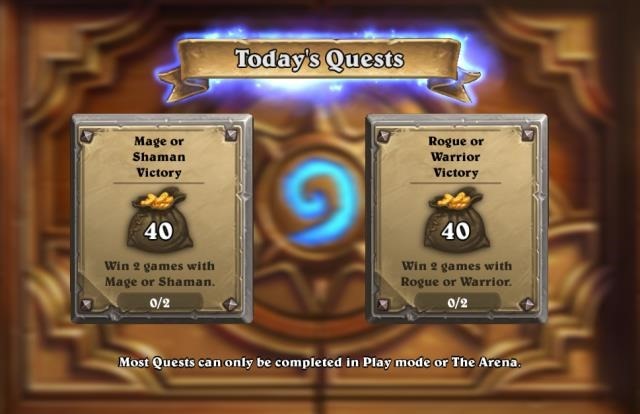
Hearthstone (which we’ve covered many times before) is a great example of this. Their mission system employs daily pacing. Instead of using timers, they pace the missions so that there is 1 new mission per day, up to a maximum of 3.
So coming back at any time the next day, you know you will get an additional mission. This is the easiest source of free coins in the game, so it feels rewarding and is tied into the core loop of purchasing card packs. But the key here is the daily pacing. There’s no timers telling the player that in exactly x hours they need to return to the game, instead they have the flexibility of natural day cycles. Have I done my mission of the day?
Days aren’t the only cycle that you can use. Weeks and Months work great at pacing players for very long timers. Hearthstone paces players by month in seasonal competitions. Because each month has a unique card back, this makes it an easy choice for a player to come back to the game, especially near the end of the month, just to get their card back.
#2 Add Animations
Another clever way to add pacing is just to use visual animations rather than timers.
For example, Hay Day had a clever mechanic in which the trader characters delay taking new deals until they’ve left and returned to your farm. After completing a deal, the character would slowly walk/drive away happy, then return soon in the future ready for another trade. This made the pacing make sense, and didn’t need a timer in the player’s face.
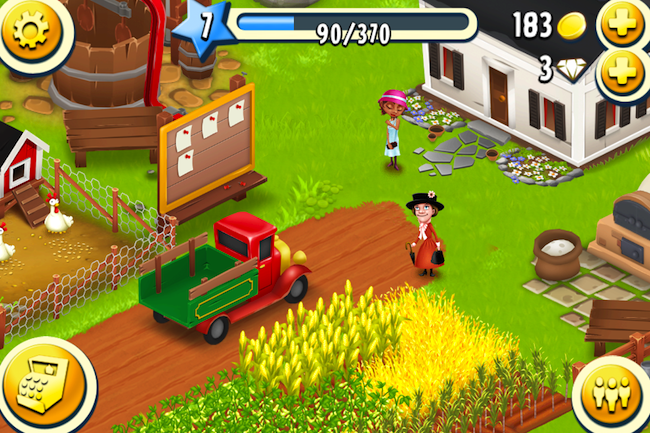
Want the next deal? Wait until the trader walks back!
Games with a large world map which you have to send armies around commonly employ a pacing mechanic where the army must take x hours before they reach the location. Showing the scale of the world relative to the unit and actually animating the units along the map helps players buy in to the fact that it takes time for units to reach locations.
Is there any shorter timers within your game that can be visualized by an animation instead of by a timer? Is there any long timer which you can better visualize to the player through animations?
#3 Get Creative with the Cost
The best strategy for making pacing feel better is to get more creative with your economies & systems. Instead of demanding the player to wait for hours for a building to construct, increase the difficulty & cost of building it to begin with.
Most systems force pacing through timers that look like this:
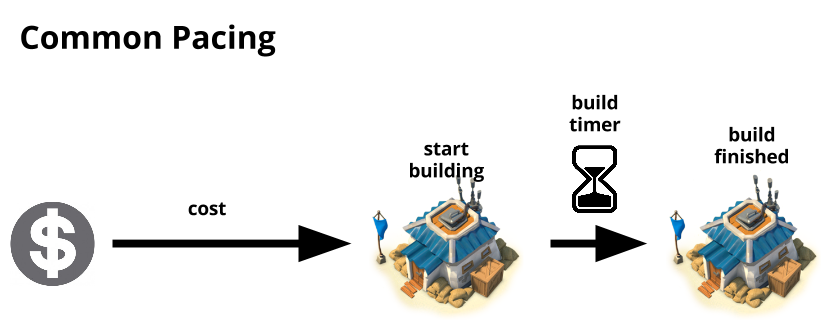
Fallout Shelter is the best recent example of a game focused on adjusting pacing to feel different and stand out. They chose to do this by shifting the economy. Instead of the pacing of the game through timers for building construction, they’ve focused their pacing only through the initial cost of the building. As a result, Fallout Shelter feels different from most simulation games. It feels instantly gratifying and very rewarding for collecting the coins.
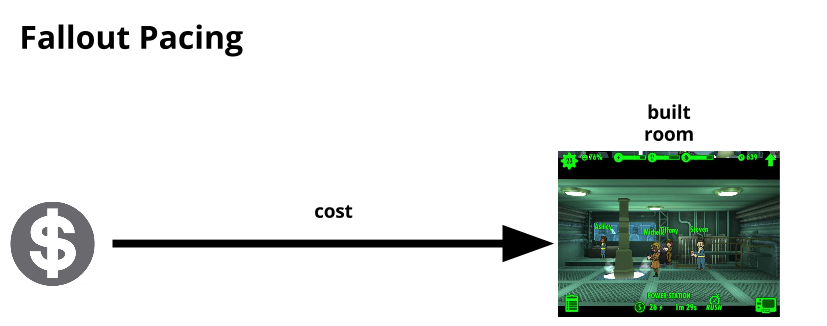
Due to this change, Fallout must increase the cost rapidly to compensate for the lost pacing with building construction and find other timers in the game for players to manage & drive sessions (in this case Wasteland Missions). In the end, this works out for Fallout Shelter, and feels like a very different simulation game from most free to play games.
But increasing the cost before the purchase can take many forms. Cost can come in the form of just collecting currency (ex. bottle caps in Fallout Shelter), or it can be a combination of luck and effort as seen in many gatcha games including Contest of Champions. To pace getting the getting the best heroes, players must grind through collecting hundreds of crystals.
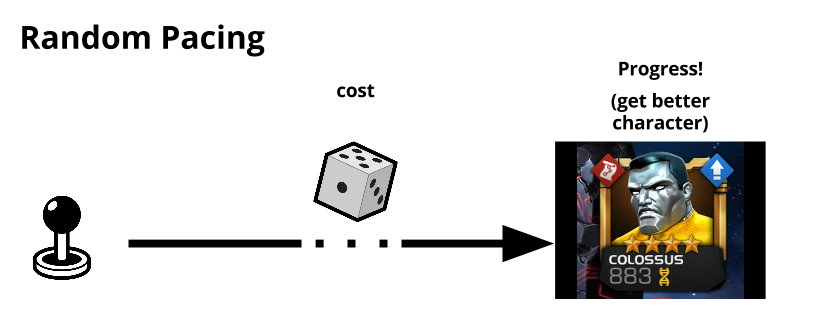
When designing a new pacing mechanic, consider the following:
Instead of guaranteeing the player the reward at the end of a long game loop, try allowing them to engage in a shorter loop, but randomize the progress towards the goal. As psychology teaches us, this type of mechanic will pull players back longer than a strict cost:reward trade off.
There are many more ways to get creative with pacing. But I would always rethink just adding a timer or just adding a high cost to an action if there are ways to make pacing more engaging to the player.
The Bare Minimum : Timers should make sense
If all the above fail, then the bare minimum for having a timer is to make sure that it makes sense with the theme.
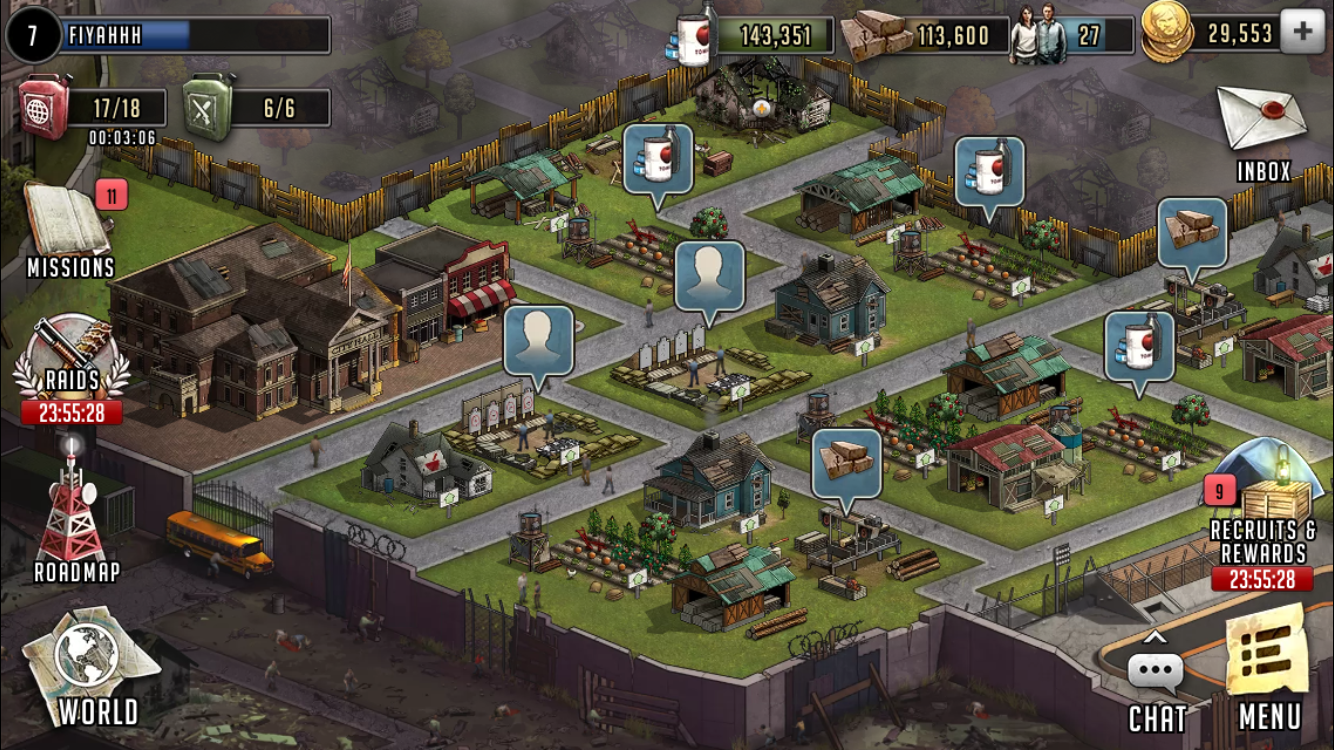
Why do all F2P games have building construction? because building timers is one of the few places where timers make sense.
This is mainly why so many games default to have a city building component, even if it’s a bit of a stretch for the concept. Take Walking Dead: Road to Survival, the F2P game from Scopely recently released. They clearly added the city building component for the ability to pace using construction timers. If they hadn’t had this component, they would have really struggled to find places that make sense to add long timers.
Agent Alice is a good example of a game that struggled with timer design.
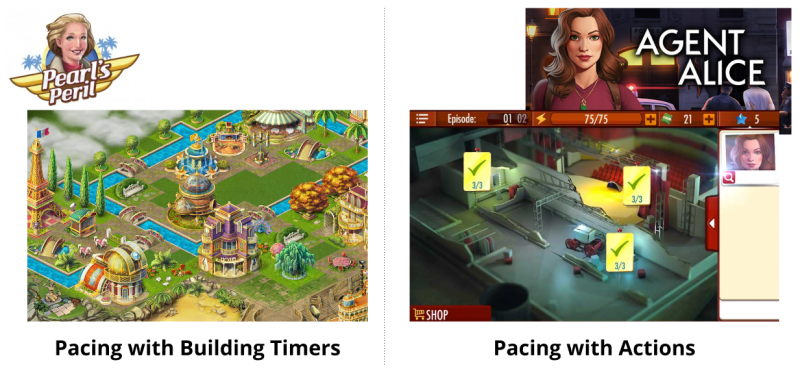
Agent Alice is a recent Hidden Object game from Wooga. Agent Alice made a big risk by removing the city building component from Pearl’s Peril, it’s spiritual predecessor. Due to this design decision, the game struggled to find effective timer design.
Where Pearl’s Peril would use building timers to pace players, instead Agent Alice had to use more arbitrary timers. The timers became different actions that Agent Alice had to take to pace the story. In the example screenshot below, Alice must plan her next move which takes a long timer.
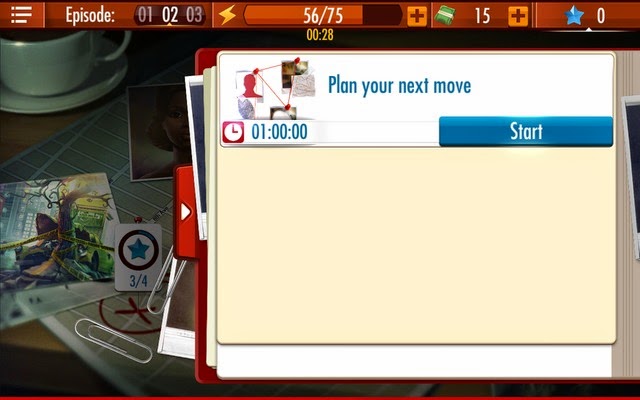
Agent Alice’s timers many times felt unexpected.
This timer is not expected by the player.
The goal of timers has to be to fit into the theme of the game. Each use of a timer leave the player feeling: “Right — that makes sense that it takes that long”.
In another hidden object example, Criminal Case, a game from Pretty Simple, uses a timer when the player has to send anything “to the lab”. This makes sense. In all the crime shows I’ve watched, this was expected by the detectives and the audience.

Sending evidence to the lab makes sense why it takes time.
Keep this in mind when designing your pacing structures. Timers have to make sense in the theme, they have to be expected by the player.
Summing Up
Pacing mechanics can be tough to get right. But slapping timers on every system isn’t the right direction, especially as our audience matures and becomes more sensitive to the mechanics. 3 ways which you can improve pacing mechanics to feel different are:
- Swapping Timers for Natural Pacing : Once per day, Once per week, Once per month. Use the natural cycles we’ve all been accustomed to.
- Use animations instead of a timer to make it feel natural & make sense
- Instead of directly using timers or an energy system, look to find ways to pace by increasing initial cost through currencies, gameplay and luck
And if none of the above is possible, do whatever you can to ensure the pacing actually makes logical sense in the game loop. Building takes time, sending heroes on a journey takes time. These can have timers. Don’t add timers to actions that don’t make narrative sense why they would take time.
Using these tips you can adjust your design to feel less restrictive, more natural, and ultimately serve this maturing audience.
Deconstructing Splatoon’s Metagame Design
What does Splatoon, a paid game for consoles have to do with mobile free to play?
Well, you can find inspiration and clever design in any medium. Just so happens I’m a massive fanboy of Nintendo, and after playing their game for months it was inspiring to spot some really interesting design bits that can be applied to any free-to-play game.
Just to give you some background, Splatoon is a multiplayer 3rd person shooter for Wii U.
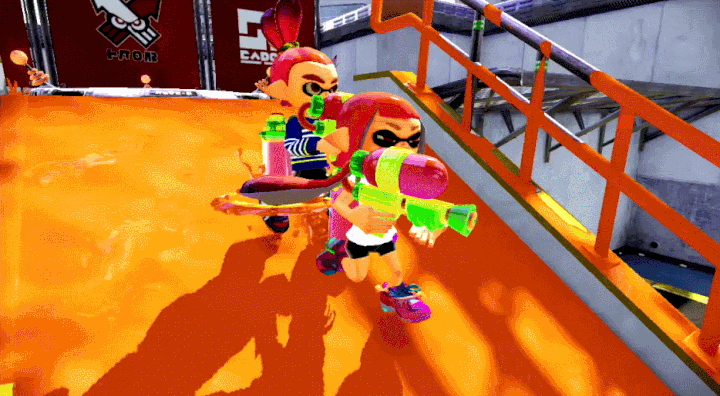
Splatoon of course isn’t just your run of the mill shooter however. Nintendo re-invented this genre from the ground up. The focus isn’t on kills, instead it is on covering the arena with as much of your team’s colour as possible. Kills can help slow down the opposition, but it is more about controlling territory than it is about camping for kills. As a result the game feels much more casual for players that aren’t interested in getting headshots, yet strategically deep for players that want to compete.
The core gameplay aside though, Nintendo did something I don’t think many designers expected. They built a masterful metagame outside the battle which drives strong long term retention. Instead of just taking the tried and true Call of Duty perk & leveling system, they’ve built something that feels great and keeps players coming back. This is something that all F2P games strive for.
Today I’d like to focus on 2 mechanics in Splatoon that can be applied to any F2P game:
#1 Splatoon Clothing
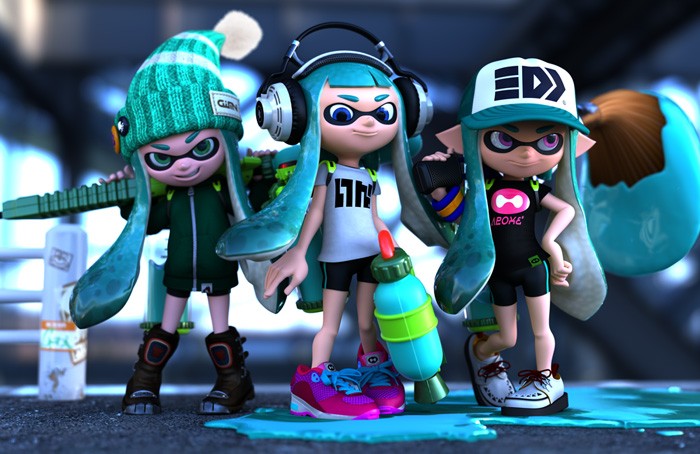
The part that binds the entire metagame together for Splatoon is the clothes. Nintendo’s design of how players get clothes, unlock clothes and level up clothes makes this game work. It makes this game last.
Nintendo could have decided to go with the tried and true method that many shooters and skill based games go with. Call of Duty pioneered a system in 2007 which many online focused games have used since. Players gain levels by playing games and gaining XP. Levels unlock new guns, new perks and new gadgets to play with in the multiplayer game. As you progress up the levels you’re rewarded with more options to choose from. This system is simple and effective, which is why most multiplayer games have used this method over and over.
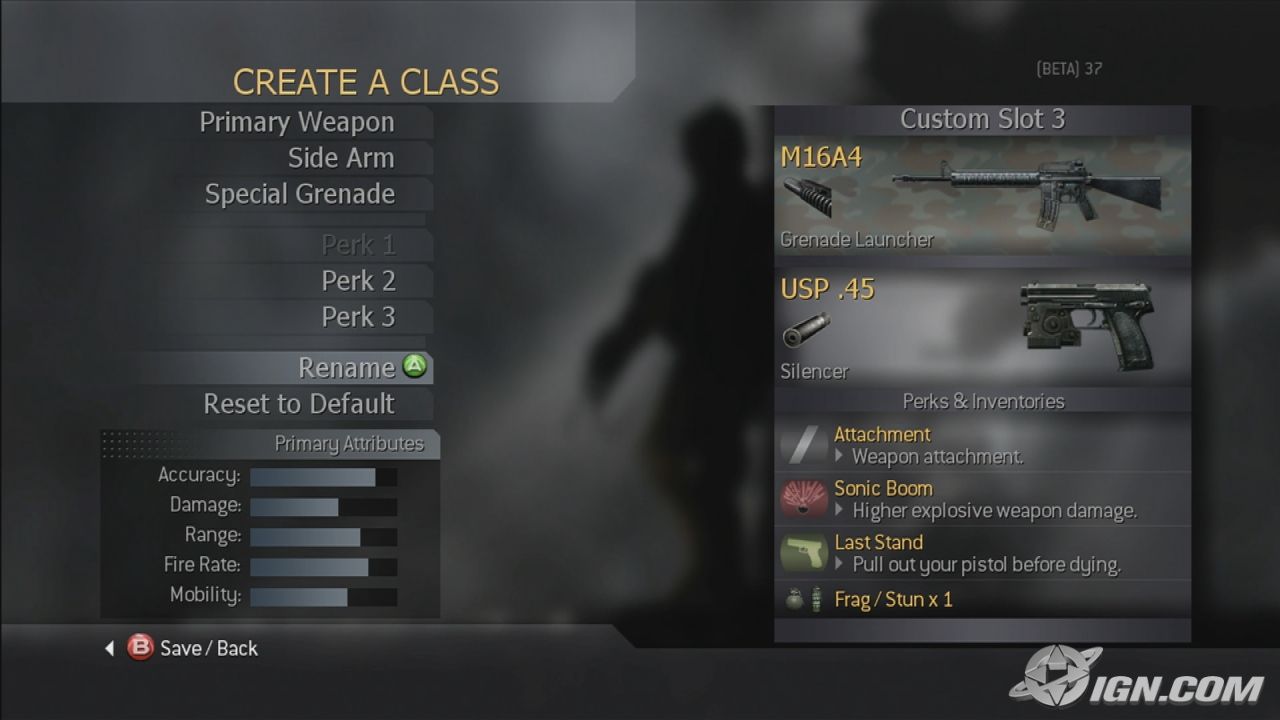
The original system that everyone uses. Levels unlock new options for the player.
But this Call of Duty system also has its disadvantages. Each player unlocks equipment and upgrades in the exact same way. So while it allows players complete flexibility in choosing their loadout, there’s very little choice in the grind. Players just seek to optimize their XP growth.
Splatoon approached this in a completely different way. Splatoon instead ties perks and abilities to clothes. Instead of players being able to freely decide which perks they want, players need to choose clothes, upgrade them, and hope that they contain the perks and abilities that they want.
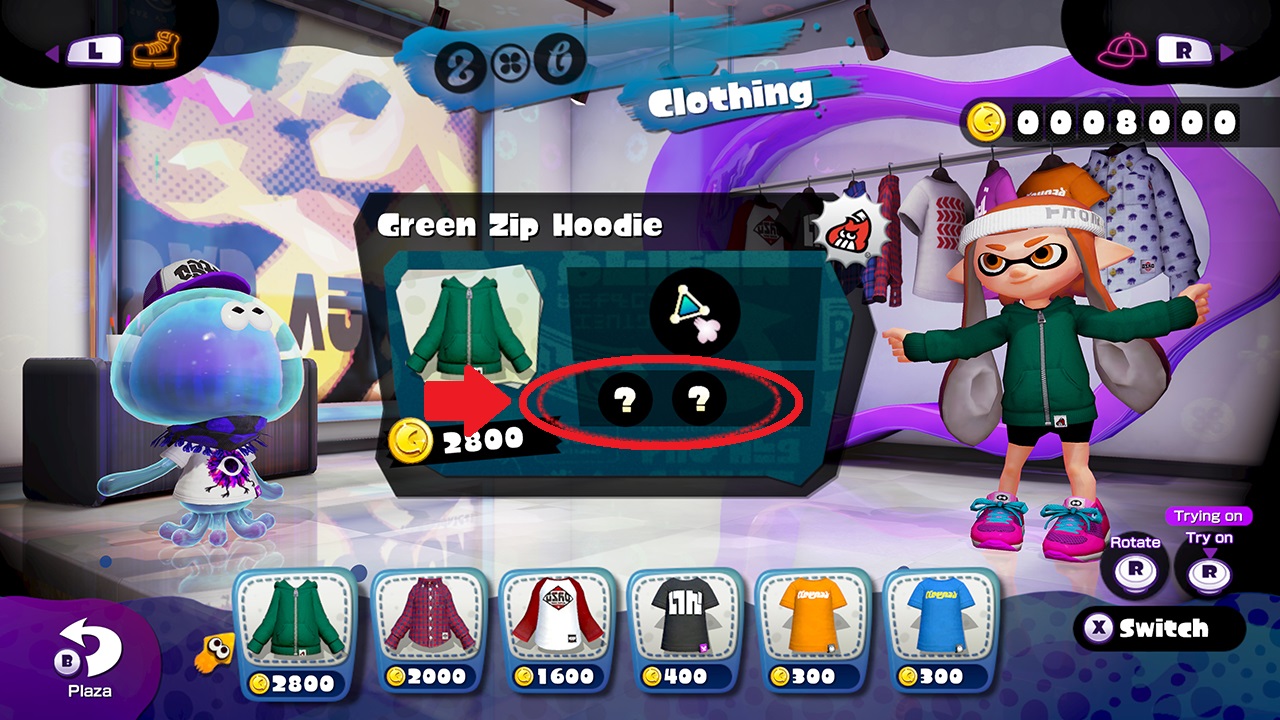
Each piece of clothing has random abilities that you must discover by playing matches with the item equipped.
On the surface this isn’t a massive difference from most MMOs or Multiplayer games. Some games decide to tie aesthetics to special abilities in a game. The key difference that Nintendo makes is that the abilities of a new item are random. When you buy a new piece of clothing, only one perk is shown. The remaining perks are slowly discovered the more you play with the item.
The result is that this system feels like each piece of clothing is like a trading card booster pack — that you slowly open the more you play the game.
This means in theory buying multiple of the exact same pair of shoes can result in different perks awarded. This system results in players opting in to grinding for the gear that both looks good on their character and has the abilities which work well with their play style. This combination makes for a very powerful long term retention driver.
The 2 key reasons that make this system work:
There is no right answer
What’s important about this system is that the abilities are designed and balanced properly so that there is no set of abilities that dominate over all others. A must in any skill-based PvP game. Each ability benefits different play types equally.
Because there is no dominant play style, players are more likely to experiment. Players naturally will experiment with different perks, seek out cooler clothing, and as a result opt-in to playing with a ton of clothes that they normally wouldn’t bother with. Just in efforts to discover new abilities and experiment with different perks.
Just like Hearthstone, or any game with a strong meta-game balance, there should not be a dominant strategy. The more intrigue that goes into players debating over the optimal strategy, the more likely that players at the high level will be happy to experiment and try out new builds.
The clothes don’t give everything away from the start
Nintendo could have simply shown all abilities on the item from the point of purchase. Because they chose both to hide the abilities and force the player to play to discover them, they created a strong drive to keep playing.
F2P designers should seek to find similar systems in their own games. In any loot-based game or gacha-style system, do you need to give away all information about an item from the start? Can you ask the player to play before they discover any special abilities?
By asking the player to play instead of immediately get the benefit, you’ve asked them to invest in your item. Just as psychology teaches us, by making the player work for the benefits, they are more likely to find higher value in the outcome.
They will be more likely to “grind” (level up) multiple versions of the same item to get the benefits they want. They will be more likely to feel really smart when they’ve lucked out and found an item that randomly had a unique ability. This will build investment in the player and drive a long lasting metagame.
As a result Splatoon’s meta game is a longer lasting system than Call of Duty’s, despite having less perks, less guns and more casual gameplay.
#2 Special Order Queue
The second interesting system in Splatoon is the clothes ordering queue. Now that you know why clothes are important and why players happily grind for them, there’s an additional system which drives players back to the game.

Players in Splatoon can walk around the lobby area and see different avatars from around the world. You can walk up to anyone and see their clothes, which perks are on them, and how cool they look. This is a good system for driving desire (“I want that hat! With those abilities!”). Nintendo doesn’t stop there though — it also allows players to order clothes they see from other players. So if you really like that hat, order it!
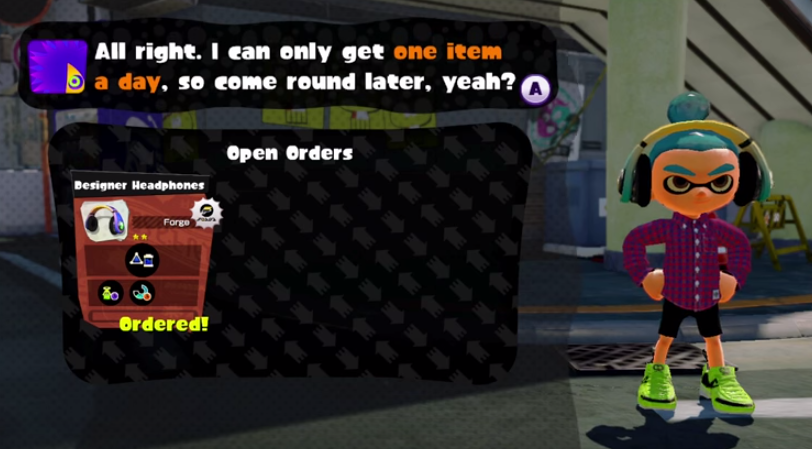
Your queue is only filled once per day. Spyke will retrieve the item for you, but with some hidden abilities.
But ordering is not immediate. Instead Spyke (a character which you order from) needs some time to get the item. To order you have to add it to your queue. An item from your queue is delivered once per day. When that day is over, if you haven’t purchased it, the item is gone. The next day you return the next item in your queue is available.
So this means:
- You as a player opt-in to coming back tomorrow to buy the item (or the days after depending on your queue)
- The rarer the item, the more likely you are to commit to returning
- When you arrive the following day, you’ve committed to purchasing this item within the time limit. You ordered it!
- If you can’t purchase the item by the end of the day, then only you are to blame. Pushing players to create a goal to play enough to purchase the item within the time frame (“I only have today to buy that cool hat! I have to get the coins!”)
- If you don’t come back to the game at all that day, the item is lost off the queue. Again, only you are to blame. You opted-in to this purchase window.
This system is interesting for free-to-play for 3 reasons:
Using the daily pacing feels natural: There’s no timer in my face, yet still paces the player. Daily cycles feel more natural to a player compared to a long timer (ex. “come back in 24 hours!”)
It builds commitment in the player: The player is now committed to come back to purchase the item, and to play the game enough to be able to purchase the item in the time it is available.
Punishment is fair: The player completely opted-in for this restriction, making the player more likely to accept the punishment if they fail. This also means that they are more likely to spend to avoid the punishment (“It’s my fault! but if I just pay $x I can avoid the punishment…”)
These 3 ingredients make for a very compelling F2P mechanic for both retention and monetization. This can be applied to any game that has a wide variety of items and gear to give away. Characters in Contest of Champions, Gear in Fallout Shelter, or maybe even cards in Hearthstone. Having an order queue which is filled on a daily basis can be a strong daily session driver. It drives strong commitment, feels natural, and feels fair.
In Summary for Splatoon
Splatoon is a very interesting game. If you have a chance to play it, I highly recommend it.
Besides the usual Nintendo charm, Splatoon managed to inspire me with a couple very interesting F2P systems:
- They drive me back to the game to find the best clothing and abilities
- I’m committed to come back to the game and play a few rounds each day to pick up my orders for clothes
These 2 key systems that can be applied to many F2P games to drive what’s most important: long term retention.
Deconstructing Fallout Shelter
Fallout Shelter shocked many people when it reached the top grossing charts. Many (including myself) have been preaching about the unchanging stasis that exists at the top of the AppStore, and Bethesda came in and changed that completely.
As the smoke cleared, and I watch Fallout Shelter slowly fade from the top charts, I’m left with: “so what did we learn?”
I don’t think anyone can doubt that the brand of Fallout was huge for this launch. It attracted loyal gamers and drove massive organic growth on the AppStore. Every game studio since the launch of Kim Kardashian by Glu has known this. To make marketing on the AppStore affordable, brand recognition is becoming more and more important.
But the marketing aside, what shocked me was the response from players to this game. Here is a game that was developed by a traditional developer, taken a brand many gamers love (as a premium title), and then changed it completely to be free to play. We have seen this many times before ending poorly (see Dungeon Keeper, Sonic the Hedgehog). So what was so different about this launch?
How did Fallout Shelter become a beacon of acceptable free-to-play design for core gamers?
#1 No Arbitrary Session Caps
Fallout Shelter never forces its players to leave. There’s always something positive to do with your vault. There’s no blocker such as energy which says “you must leave now”. But as we’ve seen in previous posts (here and here), having a limit on sessions and progression is absolutely necessary to drive long term retention.
Fallout Shelter employs what I like to call “Flexible Sessions”. The player enters the game, feels rewarded, but the game slowly increases the pressure to leave. Instead of having an abrupt end to the session with energy, Fallout Shelter slowly tweaks the gameplay so you as a player feel smart for leaving.
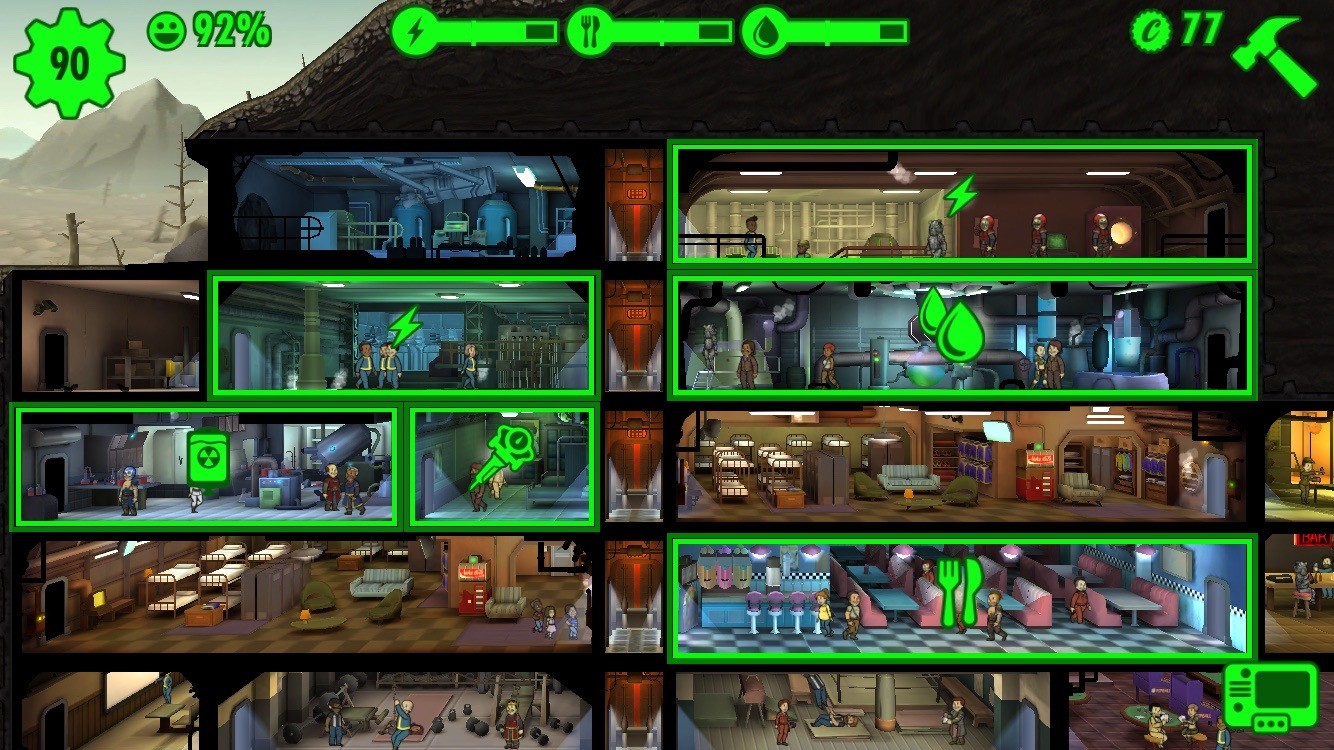
This is the typical screen the player returns to each time they come back to the game. Lots of rooms with lots of resources to collect. It feels very rewarding to return to the game every time.
Each time the player enters the game there are a ton of things to reward them. Production timers are short, so coming back every 5-10 minutes rewards the player with lots of resources and some occasional level ups of their dwellers. However, the longer the player remains in the session, the less rewarding the game is. This is built intentionally so that players eventually opt-in to leaving the game.
You want to build session design so that the player feels smart about leaving. Not told to leave.
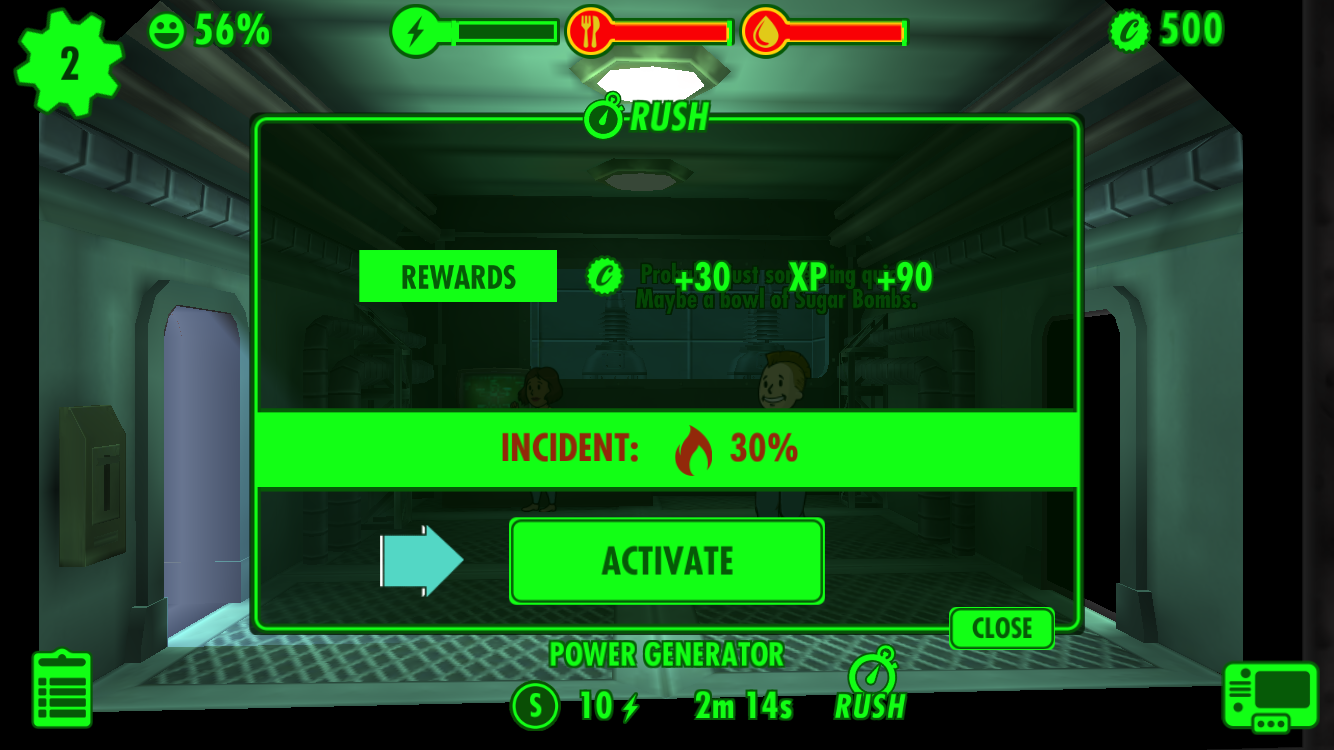
A good example of the game increasing pressure over a session is the “rush” feature. Rushing takes the place of a “skip for premium currency” button which free to play games have. For fallout, the rush feature is no longer a monetization feature, it is a session design feature. In the beginning, the player is trained to continually rush production of rooms. This rewards with faster resource production and bottle caps (a key currency for progression). However, the more you rush a single room, the higher the incident chance will go up. So the more you rush rooms, the more likely a fire or radroach attack happens. The longer you are in the session, the more rooms you rush, the higher risk you have of bad effects. It is strategic to leave and come back later.
Overall the game never really forces the player to leave. Just tries to slowly decrease the value of sticking around. So for core gamers, they never feel like they are being pushed out of the game for no apparent reason, rather they are making strategic choices about when to stay and when to leave.
#2 Disguised Pacing Structures
We can all read from the reviews, forums, and rants that gamers hate timers, pay-to-skip and energy systems. But pacing is the key to long term retention. Without long term retention, a free to play game can’t succeed (more on this here).
So how do we effectively pace traditional gamers?
Disguise the pacing systems to feel different from traditional free to play systems.
Best example of a disguised free to play mechanic is the wasteland mission system. This system is a version of FarmVille’s “plant and wither” mechanic which drove very strong commitment for players to return. Each time a player would plant a crop, the crop would have a limit of how long it was harvestable. If the player didn’t come back before this time, the plant was withered. The player would not get any value from it.
Plant and wither hasn’t been around for awhile because most designers see that player’s really hate it when their first experience coming back to the game is to be punished for not returning. Punishing players at the level of FarmVille these days results in a high churn rate (a high percentage of players leaving the game). But Clash of Clans, Boom Beach and other “Build & Battler” style games have slowly added this punishment back into the toolkit for free to play design. The longer the player is away, the more likely they are to be attacked. When they’re attacked, their precious resources are being stolen.
This fear of losing out on owned items, or “loss aversion”, is a very strong session driver.
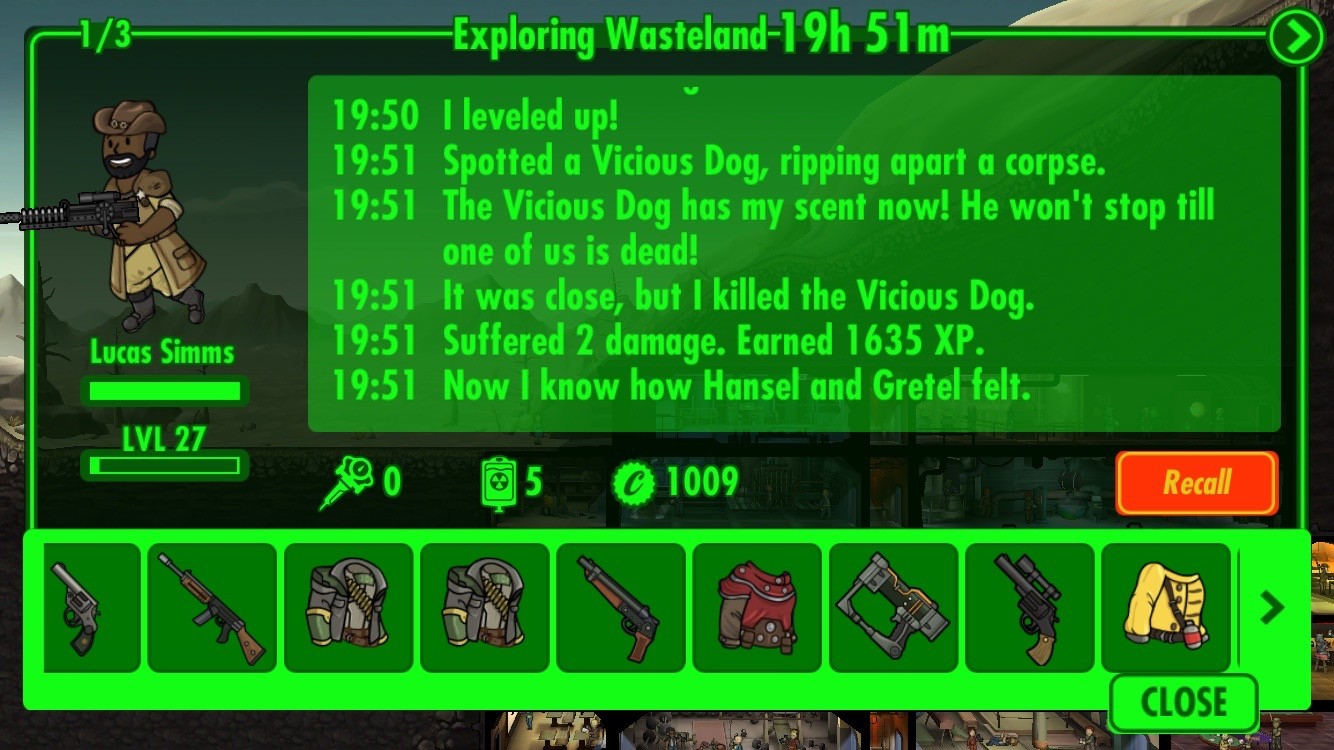
Fallout Shelter employs loss aversion with their wasteland feature. Unless the player comes back to the game before the dweller dies in the wasteland, that settler is dead. All those bottle caps and rare equipment the dweller collected? That’s gone too. Of course the player can revive the dweller, but this comes at a cost, which rises over time. “Smart” gamers are going to feel good about scheduling their day around avoiding deaths of their dwellers.
For addressing the core audience, designers will have to reverse engineer common pacing systems and rebuild them to feel something very different. The wasteland feature is an excellent example of how to do this.
#3: Gacha
Lastly, targeting their Fallout player audience, Bathesda knew they needed a fair monetization scheme. The only way to do this is with a Gacha/Card system (more on Gacha here). Fallout Shelter offers no direct purchase of resources. This is the usual method for simulation games. Drive desire for the player to spend when they’ve run out of a specific resource they need.
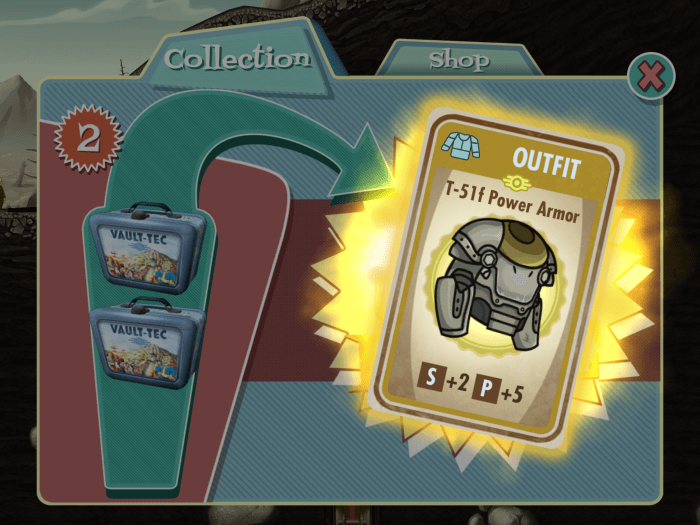
Fallout Shelter does it differently. Instead of the much-hated resource store, they have a lunchbox gacha system. Each lunchbox contains a random set of cards. Cards can be resources, soft currency, gear, or even rare dwellers. So instead of knowing exactly how much currency you’re going to get, you have the rare chance that you’ll get a rare dweller or rare gear on top of the resources you need. Thus paying for items feels very rewarding versus paying for currencies in other games. You don’t feel like you’re cheating the game (as much) instead you feel like you’re playing the lottery and being rewarded with new toys to play with.
The key that makes this core-gamer friendly is that it is fair because it is luck based. Any player has a chance at the big rare prizes.
It is fair because all players can get lunch boxes from regular play. Playing the game smartly can get you lunchboxes quicker. It also feels fair because the players that pay aren’t really impacting any other player’s experience with the game. Fallout Shelter is not operating in a PvP multiplayer environment. If they were, there would be a lot of pay-to-win criticisms. Because the game is single player, Bethesda had some wiggle room with these pay-to-progress mechanics.
Hearthstone and Contest of Champions has shown that these gacha systems can give lucrative monetization potential. However, the revenue per download of Fallout Shelter over the last few months is much lower than most top grossing games. But when you consider the downloads the game got simply because it took a lighter approach to monetization, this was probably the best choice.
Monetization methods have far more to do with what your audience expects, rather than what would be the best way to make a buck.
The Fall of Fallout Shelter
Despite the all that I’ve praised here, the game ultimately did not sustain in the top grossing. While it initially had the support of the brand, ultimately the game didn’t stick to the top charts because of the lack of content, not pacing players enough and no social gameplay which led to low long-term retention.
From discussing with high level players, the game really only lasts for maximum 2 weeks. After this, there is no new rooms, no desire for more dwellers, no new content. No goal to achieve other than optimizing your vault’s layout. For free to play to truly work, your game must last for months (if not years).
So why should you start even considering emulating what fallout shelter built?
Why should we care what core gamers think of our game?
It comes down to your audience, and knowing what they expect and what they tolerate in free to play mechanics. Games for players of mass market match 3 games require different techniques than games for players of fallout.
What fallout shelter has shown is that the core gaming audience can be a big game changer for free to play games. This audience can grow a game overnight that can take over the top grossing charts. This audience is very likely to be the ones playing your game for months, competing at the highest level. Research is showing that the big spenders on mobile aren’t new game players, these are players that have experience playing and paying for games.
Gamers have money and are willing to spend it on games that they feel treat them fairly. So as a developer, if you’re going for a more mid-core or core audience, you have to ask yourself: What did Fallout Shelter teach you?
Eliminating Energy
In my previous post Understanding Energy I explained the reasons that designers include energy systems in their games:
- Habituation
- Content Pacing
- Monetisation
- Strategic Choices
I also noted that energy systems aren’t particularly elegant systems – they rarely blend well with the setting of the game, and this disconnect makes them disliked by players. Removing or eliminating energy systems from mobile games is no easy task. There are some directions that bear consideration and further investigation though.
Pacing through quests
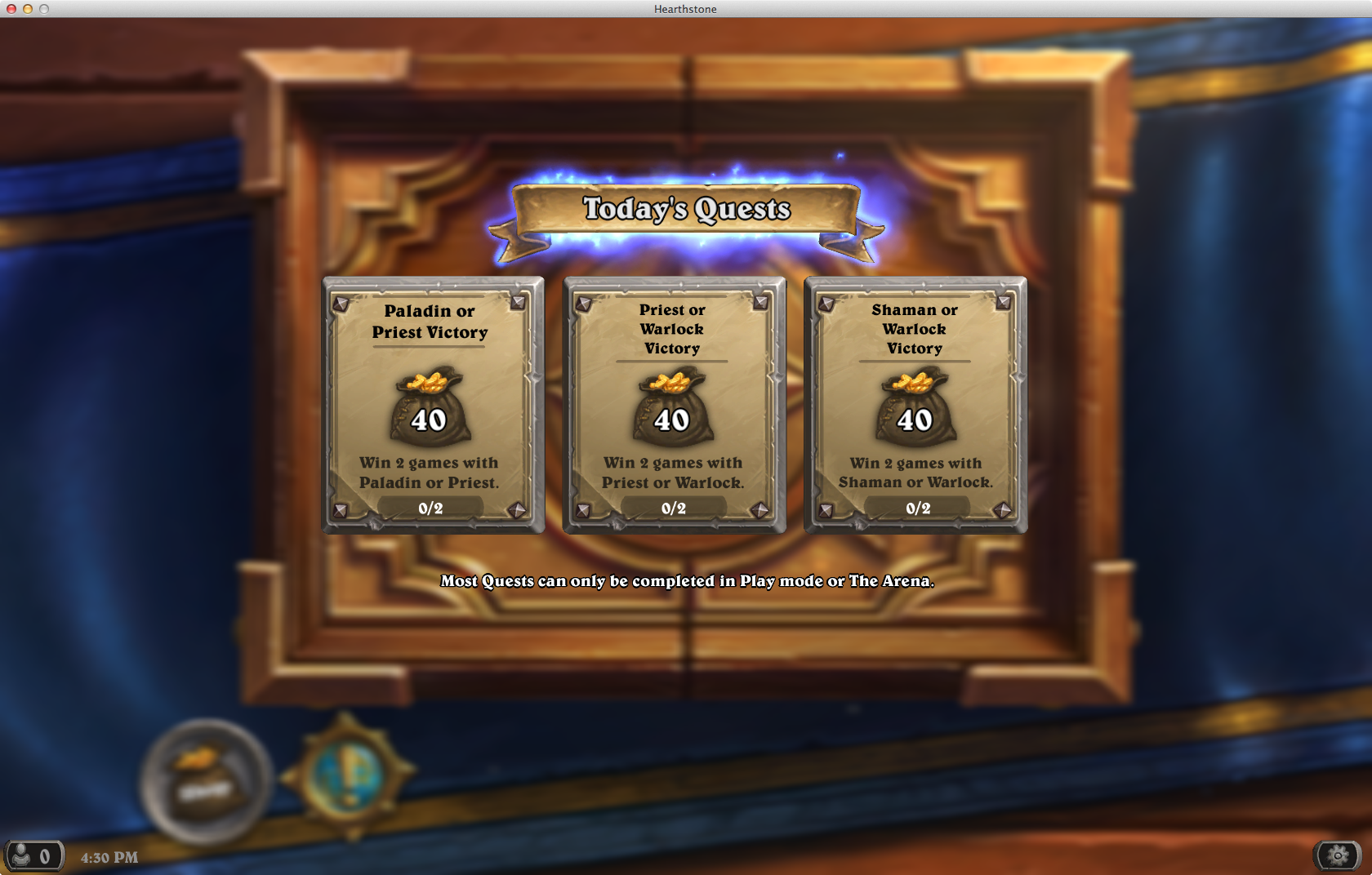
Energy systems pace players by limiting the amount that they can play. This clearly prevents players progressing too fast through a game’s content. However, it is possible to limit the rate of progression directly, whilst leaving play unlimited. The way to do this is to decouple the main source of rewards in the game from play, so that rewards can be limited independently of play time.
The best case of this is Hearthstone. Here the quest system is the main pacing mechanic, as it is the main way that players can earn in-game currency. Players get one new quest each day and each quest requires perhaps three to ten matches to complete. Once the player has exhausted their missions, they can continue playing for rank or pleasure, but their ability to earn coins is negligible and so the game economy is protected.
For most mobile games this route is likely to be the easiest and most satisfactory route to removing energy and timers.
Session length and synchronous PvP
Another way of pacing players is to increase the amount of play time required to progress. The pace that players can progress is then limited by the number of hours they can sink into the game. The big caveat to this is that it is much easier to do this on console / PC than on mobiles.
Mobile games are designed to fill the gaps in people’s days – when they are waiting for the bus, queuing for their coffee or avoiding work on the toilet. A mobile game needs to have a satisfying session possible in 1-3 minutes to fill these gaps. For a mobile game it is very difficult to give players a satisfying session in just a few minutes without bombarding them with rewards if they decide to play for a few hours – perhaps 50-60 sessions all in one go.
PC and console games have it easier as they are designed to be played in stretches of 2-3 hours at a time. A Hearthstone match lasts 5-15 minutes, whilst a League of Legends match lasts 30-45 minutes, so a few hours play is a handful of matches. This means that the base rate of progress can be extremely slow. These games get away with such slow progression because they rely heavily on synchronous PvP battles. The excitement of facing off against other people in real time compensates for slow progression in the meta game.
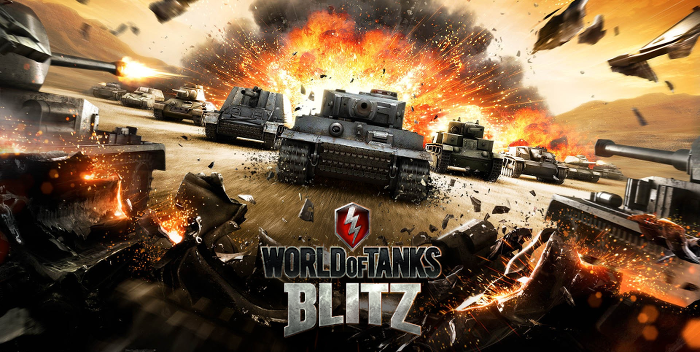
Mobile games typically have problems with synchronous PvP because people want to pick up and drop mobile games at any time, and there is little commitment to stick with match, which combined makes for a poor user experience. That said, World of Tanks Blitz has managed to be successful in spite of these challenges. Although the battles are typically only 4-6 minutes, the game still manages pace progression slow enough to avoid an energy system.
The problem that World of Tanks Blitz has is that whilst it covers off content pacing just fine, it monetizes very poorly compared to most other successful mobile games. Indeed seems unlikely World of Tanks Blitz would be successful without a PC product to support its brand awareness. 8 Ball Pool has also managed to be successful here with even shorter play sessions, but faces the same issue with revenue. Being the dominant digital version of a hugely popular real world game seems to be a major factor in 8 Ball Pool’s success.
Limited progression and asynchronous PvP
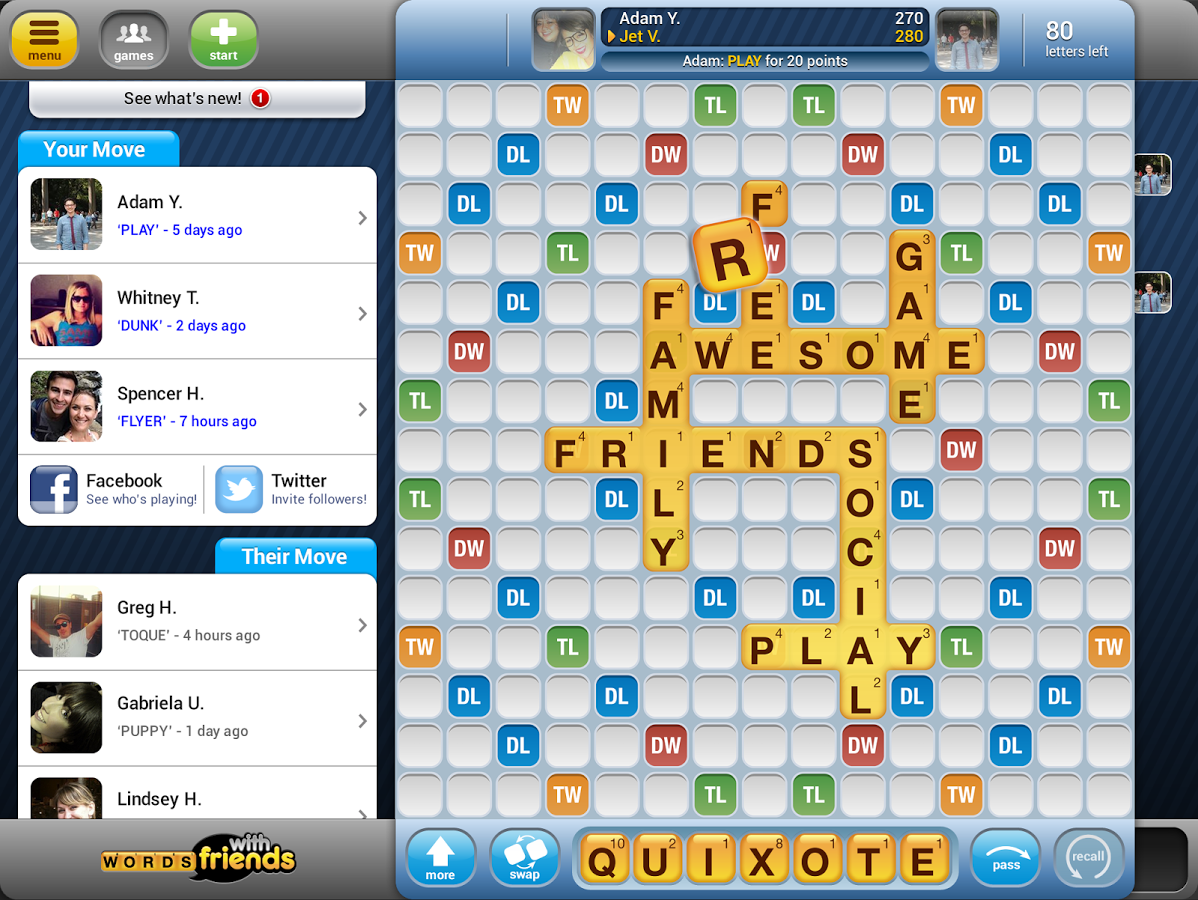
Another small set of mobile games have managed to be successful without energy systems by limiting the amount of progression available to players. Games such as Words with Friends and Draw Something offer players an asynchronous PvP experience that is incredibly viral, and where the costs of creating content are minimal.
As content is generated by other players, there is no need to limit play time. However, in order to keep the playing field fair and prevent the games becoming play to win, these games have very little to offer in terms of progression and hence to sell to players. Both Draw Something and Words with Friends rely heavily on in-game advertising to generate revenue as they have so little to sell themselves to players.
Framing
If eliminating energy altogether is not possible then framing it correctly to players can greatly improve the player experience. World of Warcraft experimented with their pacing system, primarily to habituate players into certain play patterns. Their initial mechanism halved the XP that players could earn after a certain point, encouraging them to end their session.
Players universally hated it. Blizzard responded by reframing the system, turning “normal” XP into “bonus” XP that still halved at exactly the same point, but now instead of dropping down to a penalized level, it just dropped something they called “normal” XP. Suddenly players loved the system; although the numbers were exactly the same players felt rewarded instead of punished.
In the same way, timers usually feel better than energy points. If it takes me a certain amount of time to build a building, travel somewhere or train troops then that fits with the narrative of the game and feels better than it costing energy, which appears to be (and is) an arbitrary cap on the amount I can play.
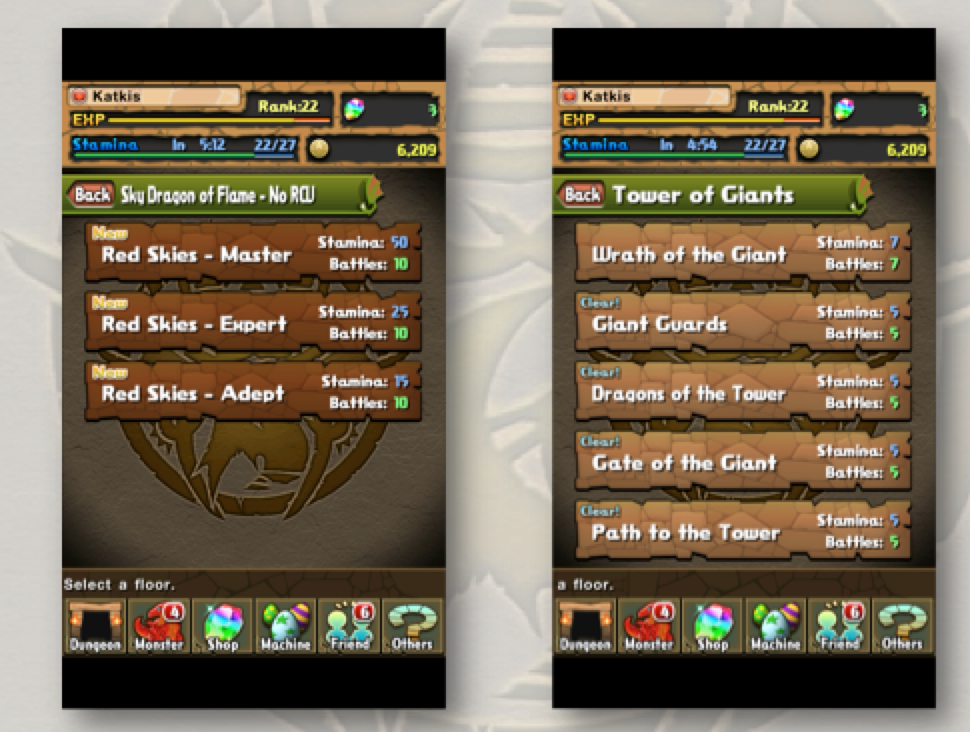
Another way to make energy feel better to players is to give players some control over it. Basically, make a game out of spending energy. In Brave Frontier and Puzzle & Dragons the amount of energy that each levels costs differs. Players have to figure out how best to spend their energy, and not leave a small amount left over and wasted.
In Boom Beach players only need to train troops if their troops die in combat. Players can therefore attack lots of different opponents in the same session, as long as they pick them carefully. The game is obviously balanced to players playing in this way, but they feel a lot smarter because of the control they have over the timers presented to them.
Conclusion TL;DR
Eliminating energy is not an easy design challenge for mobile games. Pacing player rewards is one obvious route that more games should investigate. Some games may be able to rely on PvP play and user generated content to limit the rate of progression, though monetizing these games is generally a challenge. For many games the best they will be able to do is to frame their energy systems in ways that make them more palatable to players.
Understanding Energy Systems
Energy seems to be hated by designers and players alike, so why does it endure as the hallmark of casual F2P games? The fact is that whilst it’s a crude mechanic, it’s also an efficient one, delivering several functions in one easily implementable feature.
This isn’t a defence of energy systems – I’ll follow up with a post on ways of replacing them – but without something fulfilling these roles then it’s unlikely you’ll make a very good game. I’ll talk about energy and timers fairly interchangeably here as they are both pacing systems that function remarkably similarly.
The four main reasons that mobile designers use energy systems are:
- Habituation
- Content pacing
- Monetization
- Strategic choices
Habituation
The primary reason that designers use energy systems is to encourage players to play as long and as frequently as they would like. The amount of energy gives an easy way to fix the length of the play session, whilst the energy refill rate determines the play frequency. Energy systems do this by providing the player with closure – the feeling that they have done everything they need to in a game, and that when they return there will be new, fun stuff to do.

This is why crop and resource production timers work so well. Players coming back to the game harvest all the crops that have grown whilst they are away – a hugely positive experience. Then they can use the crops to complete deals, craft things and improve their farm. Finally they plant their crops so ready for their next session. As they leave the game there is nothing more for them to do in their farm, so it feels like a natural point to stop playing; but they also know that when they return they can get the satisfaction of harvesting their crops again.
Designers need to be able to control session length and frequency because it allows them to integrate their game into their players’ daily routine. Any activity that becomes part of your daily routine is likely to be something that you keep doing a lot longer than you otherwise might, and long term retention is highly correlated to lifetime value.
Think of the game as chocolate. If you had unlimited chocolate (and limited willpower) you might binge on it to the point you were sick of it. At this point you wouldn’t want to eat chocolate again for a while. Imagine if you got a small piece of chocolate every afternoon with your coffee break though. Now the chocolate enhances your coffee break, but at the same time, you never have enough in one go to get sick of it. Instead you look forward to the chocolate enhanced coffee break, and would miss it if it was taken away from you. As with chocolate, so goes gaming.
Content pacing
The second main reason that designers use energy systems is to pace their content, and to ensure that players consume content at roughly the same rate. Once players have run out of new content to experience, they usually have little interest in a game. It is vital therefore, to ensure that players are not consuming content faster than you can produce it.
Energy systems are crucial to minimising inequality in game economies; they ensure that players all consume content at roughly the same rate
PvP games often have an advantage here because their players effectively produce content for each other to consume. In Clash of Clans, each player’s layout of their base is unique and interesting for other players to attack. But Clash of Clans still needs to bring out new units, upgrade levels and features on a regular basis to keep their most engaged players.
Energy systems also help to reduce the “distribution of wealth” in games that exists between highly engaged and less engaged users. By capping the rate that the most engaged players can play, they cannot get too far ahead of the less engaged players. This is important for balancing, as a game should remain interesting for both types of players, and setting a progression rate that is interesting for the slowest players and yet doesn’t allow the fastest players to run out of content can otherwise be a challenge.
Monetization
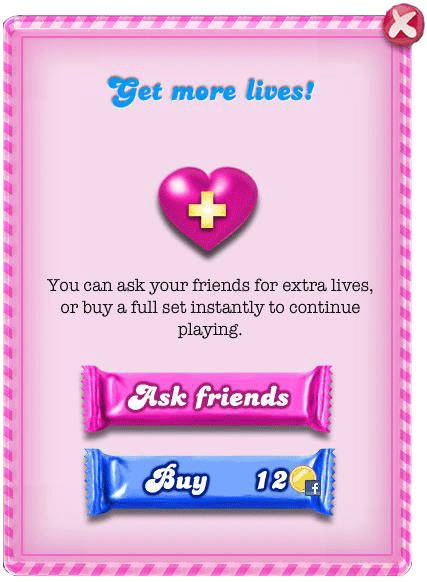
Making money is the third reason that designers use energy systems. In casual games energy might typically represent a third of bookings. This is not insignificant, but there are better ways to make money out of games, and monetization alone is a poor reason to go with an energy system. Energy doesn’t typically make for a very exciting or satisfying purchase, as it gives players something that they could get if they waited a bit longer. Most mobile designers realise this and despite the perception of energy systems as a cynical way to extort players, it is rare to see them if they are not needed for habituation and content pacing as well.
Strategic choices
In some games energy systems also provide the player with a strategic choice that they need to make. This comes from having a limited number of energy points to spend each session, and a greater number of possible actions. Players must decide what to spend their energy on, and because of this they usually need to set themselves a longer term goal that they are working towards over several sessions.
For example, in Clash of Clans, because I can only upgrade 2 or 3 buildings at a time, and each one might take anywhere from a few minutes to a few days, I need to work out what I prioritise. Do I upgrade my resource generating buildings first to facilitate further upgrades, my storage space allowing me to raid more, or my defensive buildings to protect what I’ve got? In prioritising my current session, I also create a mid term plan for my future sessions as well, which builds off this. In games where the energy system doesn’t allow the player any real choice in what they do, the system typically feels even more arbitrary and restrictive.
Conclusion
The reason that F2P designers use energy systems is not because they hate players, it’s because energy systems are efficient mechanics to encourage specific play patterns, pace content, monetize a game and provide a player with strategic choices. Designers should be wary of releasing any game without features that cover all these bases one way or another.
Deconstructing Hearthstone by Blizzard
Blizzard’s Hearthstone has defined collectable card games (CCGs) on mobile over the past year, and with the recent launch of the versions for smart phones on both iOS and Android the mobile revenues have rocketed roughly sevenfold.
Hearthstone is an interesting game to look at, because it breaks so many of the conventions of mobile F2P:
- It has no energy system
- It sells only permanent items
- It is highly skill based
- It is mainly synchronous PvP
As such it appeals to a lot of self designated “gamers” that find other mobile games somehow below them. This run down of the game will take apart the main features and discuss how they create and great game, and whether there are larger implications for the mobile F2P industry.
Core Loop
The core loop in Hearthstone is incredibly simple:
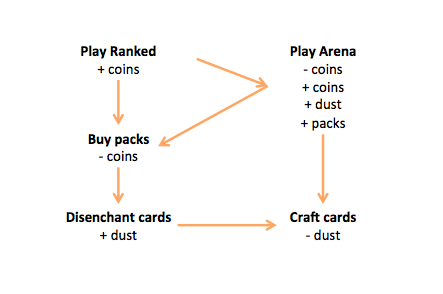
There are two main play modes: Ranked and Arena.
Ranked can be considered the basic game mode, where players play against each other synchronously to climb a monthly ladder. Players use decks that they have constructed from their permanent card collections. It is free to play, and players earn coins for winning matches and completing quests that appear daily.
Arena can be considered a secondary play mode, but is hugely important to and complements Ranked play. Here players also play synchronously with each other, but they must pay an entry fee – either coins or real money. Players make a deck as they enter the arena, choosing one of three cards at a time until they have a full deck. The rewards depend on a player’s performance, but can be generous compared to the entry cost.
The balance of the two modes is important, because it provides both payers and non payers, as well as players of different skills something to do. Earlier on, players may find Ranked play easier as they learn to put together decks that rely on specific combos. Later on they may find Arena more fun as there is the challenge of putting together a deck on the fly, and all players have the same chance of getting legendary cards.
Pacing

Quests act as the pacing system in Hearthstone, but it is so well framed that many players don’t see it for is. Rather than restricting the number of matches that players can play in a certain time, quests limit the amount of coins that a player can earn. Players get one new quest each day, and are limited to having three in total at any one time. Players can earn small amounts of coins for winning matches in Ranked play (10 coins every 3 wins), but this is small both compared to the time it would take to play these matches (perhaps 30 minutes or more on average), as well as the coins earned from quests (40-100 per quest).
As players earn most of their coins from quests, and not from playing matches, Hearthstone has no need to limit the amount of times a player can play. Players can (and do) sink hours into climbing the rankings without breaking the economy, as after the first few games their in game earnings are virtually nil. This is such a simple yet effective feature I am amazed that more F2P games have not copied it – energy systems are by far the most hated, yet standard F2P systems.
Single currency, single resource
I count coins as the single currency in Hearthstone and dust as the single resource. Hearthstone does not have a soft currency for everyone and a hard currency for payers. It follows therefore that it does not have items that can only be bought for hard currency. Purchasable things in the game can either be bought for either coins or real money. Dust is reserved exclusively for crafting specific cards.
The fact that as a non payer you can get anything in the game, and you can earn coins at a reasonable rate, helps create an environment that seems fair and inviting for both payers and non payers alike. Whilst the temptation to drop real money on a bunch of packs is constant, it never feels like someone has beaten you just because they’ve spent money on the game.
Permanent purchases

The nature of card rarity in Hearthstone also supports the feeling of fairness. Cards have one of four rarities: common, rare, epic and legendary. However, in contrast to many of the other mobile CCGs, cards cannot be upgraded or fused. This means that buying cards always results in a permanent addition to your collection, either directly or through the crafting system.
As with all CCGs there needs to be some method of dealing with duplicate cards, to maintain the randomness of pack opening. Hearthstone only allows players to have two of each card (one of legendaries) in their deck. Duplicates beyond this can be disenchanted for Hearthstone’s main resource: dust, which in turn can be used to craft any card in Hearthstone. The conversion rate is obviously not great – cards give only 25% of their cost to craft when they are disenchanted, and making progressively rarer cards gets ever more expensive. You need to disenchant 320 common cards to craft a single legendary. But the system does mean that even if players only get duplicates through randomly opening packs they can work towards specific cards that they want to create particular decks.
The fact that purchases result in permanent items that cannot be taken away from the player makes them all the more attractive. Players know that if they get a legendary card they will always have it, and its power will stay constant. Players can still spend huge amounts of money on the game, as there are so many cards to collect and the chance of getting a legendary is so low. Various Reddit posts put the cost of a Legendary at around $12-24, so with 67 legendary cards currently players could easily spend over $1,000 getting all of those alone. The cost of the epics and rare cards would be on top of that, and players can pay 4x for cards with a gold back – a purely cosmetic change.
Buying Experience
[youtube https://www.youtube.com/watch?v=_N0p4YSXn4Q]
The permanence of purchases together with the overall polish in the game creates an incredibly positive buying experience. You would expect nothing less from Blizzard of course, but the pack opening sequence is spectacular, especially when compared to the drab experience in many mobile F2P games to skip a timer or add more resources. Buying something feels great, a detail that is all too often overlooked.
Skilled play vs. Pay to Win
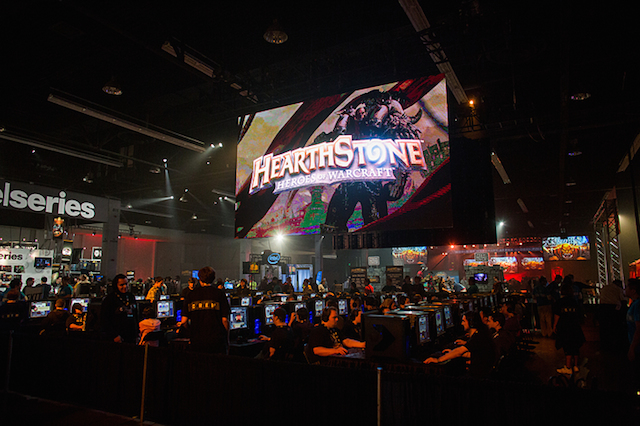
Most mobile F2P games steer clear of including too much skill. Skill makes games more difficult to balance, as players will have a varied experience of the same content. Furthermore, with highly skilled games it is difficult to give players a continuous sense of progression, as their skill level will typically plateau after an initial learning period. As most mobile F2P games are selling progress, they need to maintain the sense of progression that grind based games give, as ensure that players have broadly the same experience by leveling the playing field with luck.
In contrast, Hearthstone has a high degree of skill – the game has an impressive number of tournaments and events, and Blizzard host a World Championship at BlizzCon that had a prize pool of $250k last year. Youtube and Twitch are awash with Hearthstone matches and the top players are starting to make their fame and fortune from the game. This is clearly a far cry from games like Clash of Clans or Game of War, where success largely depends on the amount of time (and money) players can grind into the game.
That said, in Ranked play, working your way up gets more difficult the higher you go not only because you meet more skilled opponents. Any player will tell you that you need to both have the right cards to put together in a deck to create the right combos, as well as the ability to change your deck as you go. This flexibility is vital as the meta game changes as you move through the ranks. At a given time, rush decks might be unstoppable at ranks 20-15, but easy prey above rank 10.
Always having the right epic and legendary cards to finish off your deck becomes essential, but you rarely need very many of them to create a good deck. The pressure to spend is in having the necessary breadth of cards, rather than a deck construct solely of very rare cards. This creates a dynamic where players do need to spend to play at the highest levels, just as League of Legend players need to practice with all the different Heroes rather than just the ones that are freely available that week. At the same time each individual card is balanced for its mana cost and players who have spent a lot of money to acquire a lot of different cards might be beaten by a player who has spent very little, but happens to have the right cards for that particular battle. Players must spend to progress in general, but matches don’t feel pay to win.
Synchronous PvP
Hearthstone is one of the only successful mobile games to centre on its synchronous PvP experience. Vainglory and others have tried to take this challenge on, but no one else has succeeded except another game backed by a massive desktop IP: World of Tanks Blitz. Hearthstone was in beta on PC 9 months before coming to iPad, and had half a million downloads before it even hit the App Store. This period was essential to give them the critical mass needed to match players with each other at an appropriate level. Without it players would either be facing long wait times every match they played, or getting matched against players of very different skill – either case is a potentially game breaking experience.
Blizzard’s ability to drum up this level of interest in a new game is a testament to their expertise at launching new synchronous PvP games, but absolutely not a reference that other developers can hope to emulate. Without Blizzard’s existing World of Warcraft IP, installed fanbase, community management efforts and PR, the game would have faced a much harder prospect of building the community necessary for critical mass. I do not believe that we will see a synchronous PvP based game successful on mobile without a PC version any time soon.
Conclusion
The success of Hearthstone, combined with how different it is from many other mobile F2P games makes you expect it would have a huge impact on the prevailed design trends in the industry. The pacing system in particular seems superior to the energy systems that are still prevalent in many games. However, the fact that Hearthstone was launched PC first on the back of the huge World of Warcraft brand has allowed a number of other differences that the vast majority of mobile F2P developers cannot hope to emulate.
GDC 2015: In it for the Long Haul
Recently I spoke at GDC 2015 in San Francisco with my colleague Sebastian Nußbaum. We conducted a talk called “In it for the long haul: How Wooga boosts long term retention”. We were both amazed by the response. The GDC feedback was extremely positive: we ranked #1 of all F2P talks in the GDC Summits.

To view the video of the presentation, you will need GDC Vault Access. You can view it here. The slides of the presentation can be visible here.
We discussed the importance and difficulty of delivering strong long term retention. My half of the presentation focused on creating long term retention during prototyping/pre-production, while Sebastian discussed how they delivered long term retention through Narrative design in Pearl’s Peril.
Just as a summary of my main points:
- Long Term Retention is the biggest differentiator of the Top games to the rest of the F2P market
- Long Term Retention is more important than monetization or broad audience appeal
To create long term retention:
- Create a long term goal or aspiration
- Create mechanics that encourage players to invest in the long term of the game
- Create session design that both pulls players in 6+ times per day, as well as paces players naturally in the progression
- Create social mechanics that require players to rely on others to play at their best
- Understand the cost of content production by your team vs content consumption by your consumers. This must be a healthy ratio.
To test long term retention of new concepts, during prototyping focus on creating a game that lasts for 1 month of fun.
Stop any game that doesn’t show it can scale to one month of fun. Games that struggle at this point have a dangerously low chance of figuring out long term retention during production.
Deconstructing King of Thieves
Let’s take a deep dive into ZeptoLab’s latest game King of Thieves. Launched in February 2015, this game has piqued my interest. While not on the top spot yet, the game’s bold design deserves a look.
In my opinion, this is a game that deserves to be successful. It feels unique and has all the elements that make up a top grossing game. ZeptoLab has taken what works in simulation and strategy games, and applies this to a totally new genre and a completely new target audience.
This approach is what I feel more new game designs should do to be successful on the AppStore.
The Pitch
The pitch for King of Thieves is “Super Meat Boy” combined with “Clash of Clans”.

The core gameplay is a one-button platformer. Your Thief (the little cute black shadow) automatically runs left or right. You can tap to trigger a jump in the current direction. You can also jump off walls to reverse the players direction. ZeptoLab has managed to give classic platformers a mobile makeover. With one-touch controls it feels native on mobile. With simple rules, it feels expressive and gives players plenty of options. The gameplay is simple and is very transparent about what you did wrong each time you die. This creates very addictive core gameplay.
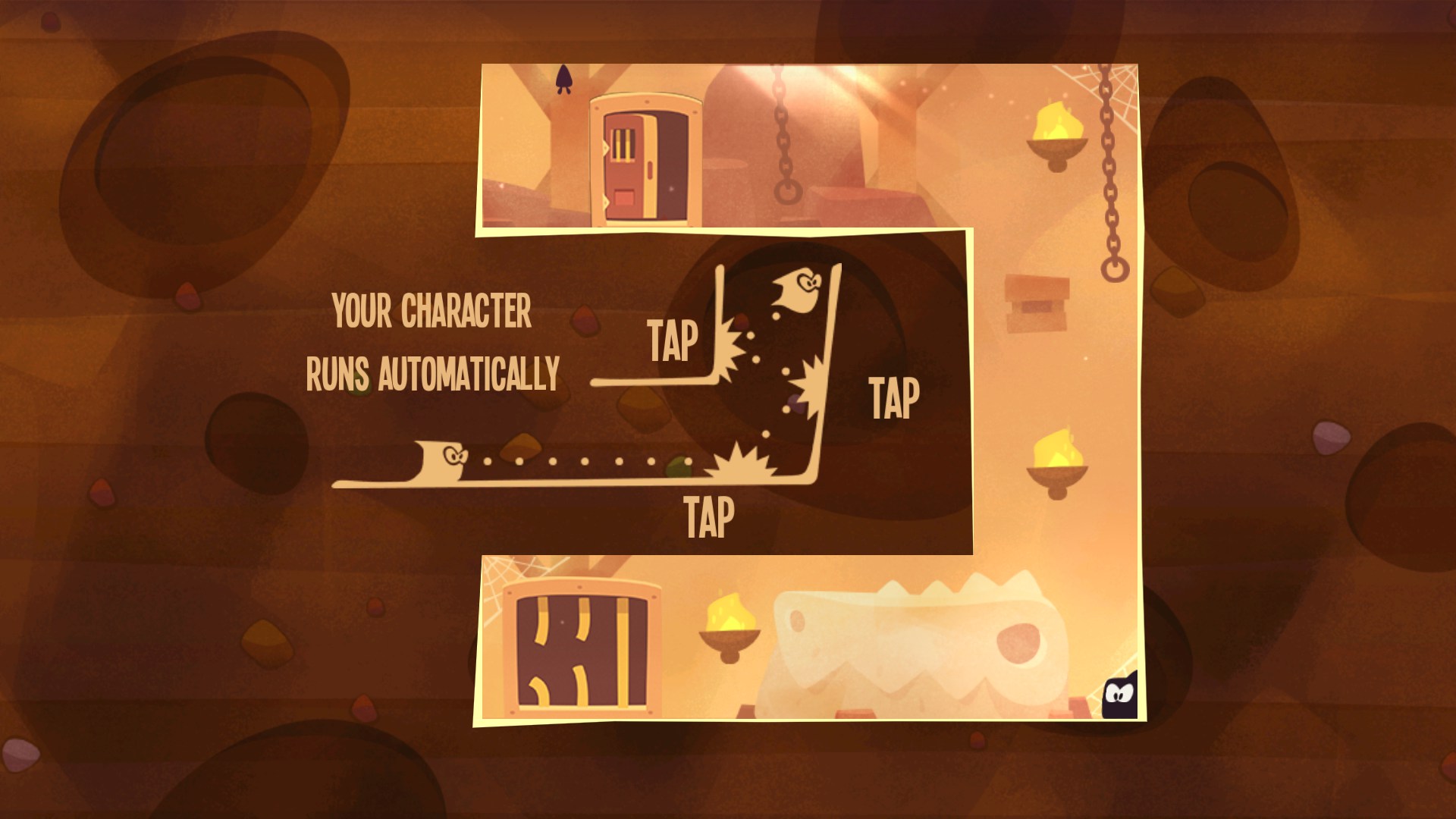
The object of each level is to reach a treasure chest. Go from “point a” to “point b” by avoiding traps. Hitting a trap will reset your progress right to the beginning. This punishment gives the game the “Super Meat Boy feel”. Reasons for losing are always clear to the player, and there is very little friction to restarting. The player jumps back into the action as soon as they are killed, making it extremely addictive to just keep trying to beat a level.
The meta (the progression systems outside of the core platformer gameplay) is a re-hash of Clash of Clans. They’ve managed to modify the standard Clash of Clans formula into something that works very well with the core platformer gameplay. Just like Clash of Clans, King of Thieves asks the players to manage two layers of gameplay: attacking and defence. On attack, the player plays platformer style levels to steal gold and gems (more on this later). On defense, the player must design a base that defends against other players’ attacks. Players sessions are focused on stealing as much loot from players around the world to upgrade their own abilities.
The Session Loop
To deconstruct, I’d like to focus on session design. To do this, we need to break down the game into its daily action loop: the repetitive actions the player takes to progress in the game. Let’s evaluate each step in regards to how it impacts the way the sessions feel.
Looking back at the post on Flexible Sessions, the key principle of designing sessions is about creating a diminishing curve of value for sessions per day and for session length. Just to reiterate: The first rule is that the first session of the day should feel more impactful than the 2nd, 3rd, or 4th time the player returns. By the 5th+ session, this should give minimal value to the player. The second rule is that session length should also have a diminishing curve of value. Eventually a player should naturally feel that returning at a later point in the day would be more beneficial. These two rules make up strong session design.
So how does King of Thieves execute this?
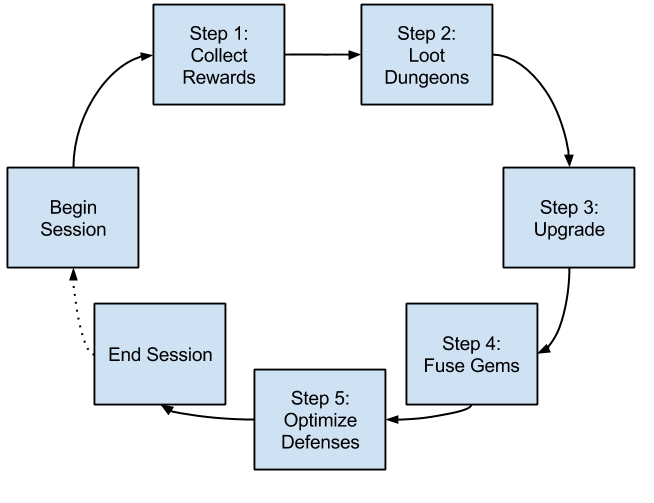
Step 1: Collect Base Rewards
Each day the player begins their session with collecting the rewards from their dungeon:
- Collect gold from their stash. (Optional Short Timer)
This is a bucket-filling mechanic. Allowing players to collect from the stash as many times as they wish throughout the day.
- Collect gold from successful defences. (Short Timer)
Making sure players feel good about their defences, players collect gold for every failed attempt by other players in their dungeon. While not a lot of gold, this certainly feels good when you’ve come back after a long absence
- Collect generated gems (Long Timer)
Gems generate on the map on a longer cycle (multiple hours).
You can see here that these three reward cycles each have varied timer length, which allows for strong session design. Short timers to value coming back more per day, but longer timers to reward daily play. Using rewards of varying length, the player has a clear diminishing value for returning multiple times throughout the day.
Step 2: Loot Dungeons with Keys
After the player has collected all their rewards, they want to maximize their cash for their current session. There is always the threat that other players in the world will steal any resources they have when they leave the game.
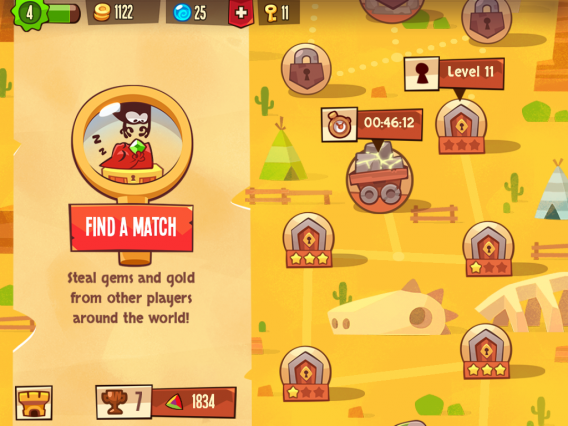
Players can choose between the PvP (left) or the PvE (right)
To do this, players loot other player’s dungeons (PvP levels) or designer-created levels in a map (PvE levels). Player-created levels hold high value gems. Whereas the PvE levels have higher gold rewards (sometimes), unlock new gem generating mines and new dungeons which the player can move to. This system works because both PvE and PvP benefit the player in different ways.
King of Thieves innovates with their pacing mechanics. Instead of using energy or lives like in most games, they use “Keys”. Keys refill like in most games with time. The key difference is that the amount of energy (or keys) the player needs to spend to enter a level is randomized.
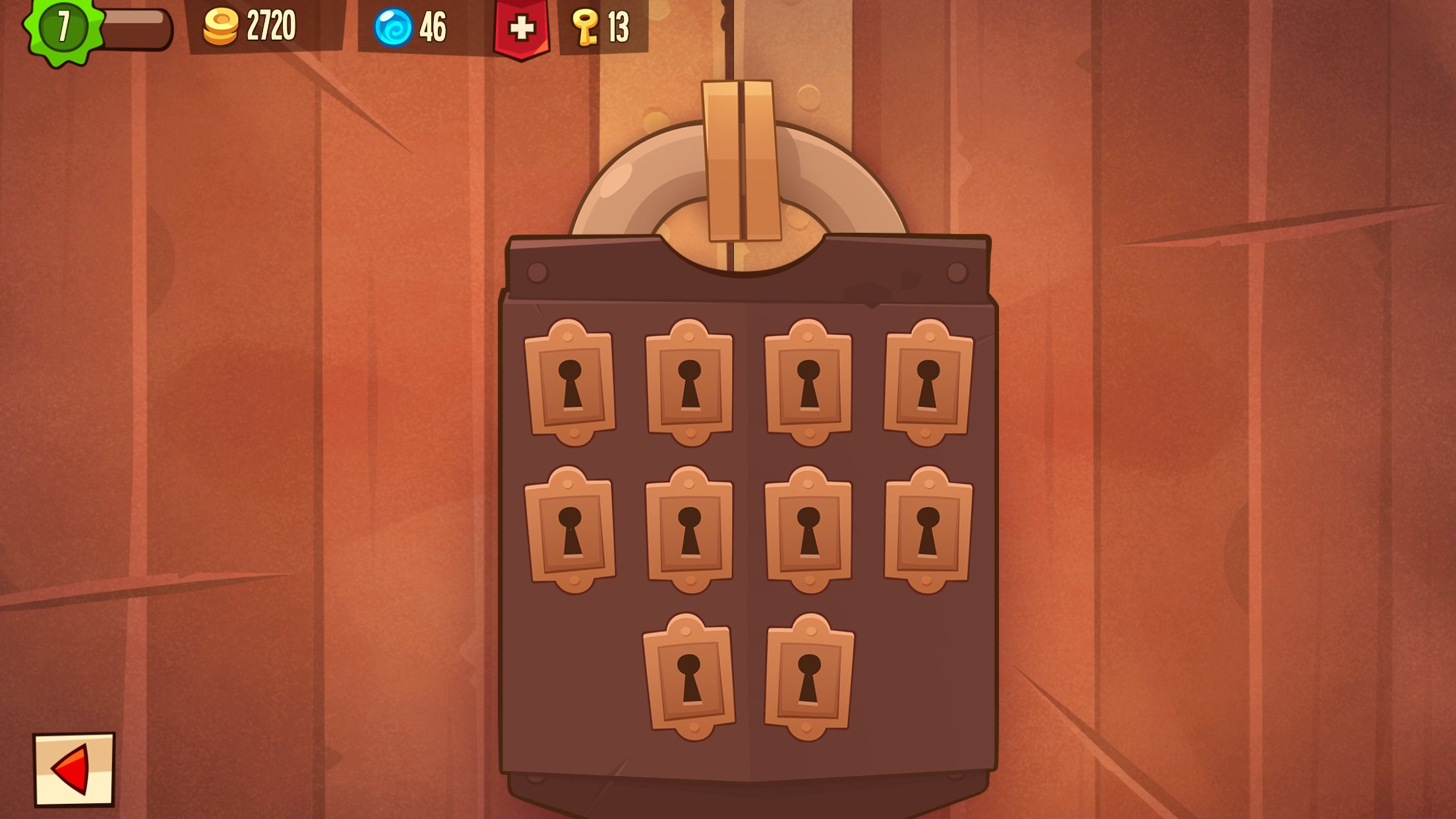
Players can choose a lock. Each attempt costs a key. Only one of them gains entry. Randomized Energy.
The player chooses locks on a screen with their keys. If they get the right key, they enter the level. If they choose the wrong one, they must spend another key. The game supplies the player with more than the usual amount of energy (10+). However, some levels can use 1 key to enter, others up to 15 keys to enter. Why would ZeptoLab design a system like this?
This system doesn’t please all player types. I’m convinced ZeptoLab benefits more from this system than the player experience. Not an easy choice I’m sure as a designer, but these sacrifices are sometimes necessary in a free to play game.
From the onset, this system feels arbitrary, just like an energy system. The player’s ability to loot is capped by some tacked on economy. Compared to Clash of Clans, Clash’s pacing mechanics make sense: you will eventually run out of troops to loot opponents. King of Thieves just says you run out of “keys”. Could this be fixed if the player had to “craft” keys in their base? Could this be fixed if the player had to build clones of their shadow player to start looting? Maybe. Overall I’m not a fan of the system, but I understand the benefits for ZeptoLab.
Because the system is randomized, players can try for one more level even if the player only has 1 or 2 more keys left. If they get lucky, this feels great. They get to play the level with little cost. If they fail, they are presented with this screen:
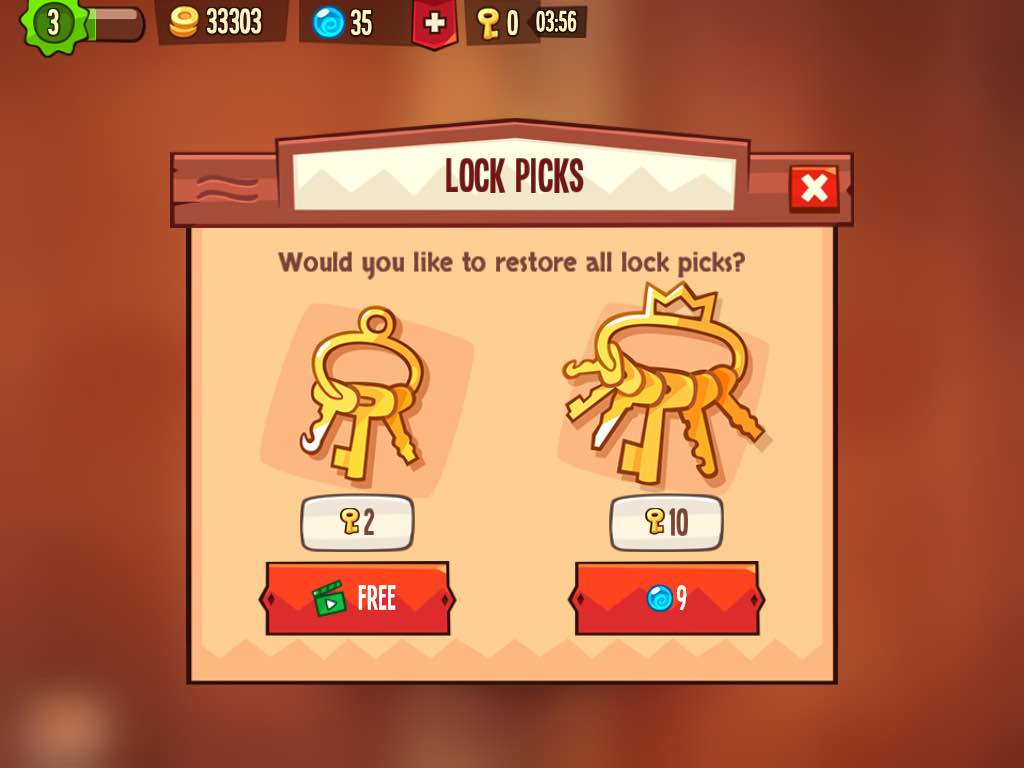
This screen is a high conversion screen for their video ads. Want to keep trying? Watch a video ad. Video ad revenue is becoming more and more interesting in the mobile free to play space, and I completely understand why ZeptoLab wanted to create a pinch point for this type of system. Players then binge watch some videos to get in that “just one more play” feeling.
On top of converting players with video ads, this type of randomized energy system also creates a nice way to balance harder and harder levels. Players can upgrade their key storage limit to be able to reach higher and higher levels. The higher the level, the more locks that the player must attempt. Also, this can create an interesting session per day value curve. ZeptoLab can use metrics like sessions per day and session length in their decision about how lucky the player is. This may be dubious, but this type of “invisible hand” to guide the session design can be very powerful.
In the end, I’m unsure if this system of randomized keys was the best choice for King of Thieves. The system is a unique design and I’m excited to see what the market thinks of it. Just based on the conversion to video ads, I think this could be something to try for other genres.
Step 3: Upgrade Your Base (or Else!)
After the player has looted as many dungeons as they could in that session, they may use their found coins to upgrade their dungeon and resource generation. Any coins left over will most likely be stolen, so players attempt to spend every coin they looted. This promotes going for one more looting session, or extending the session to purchase more gold.
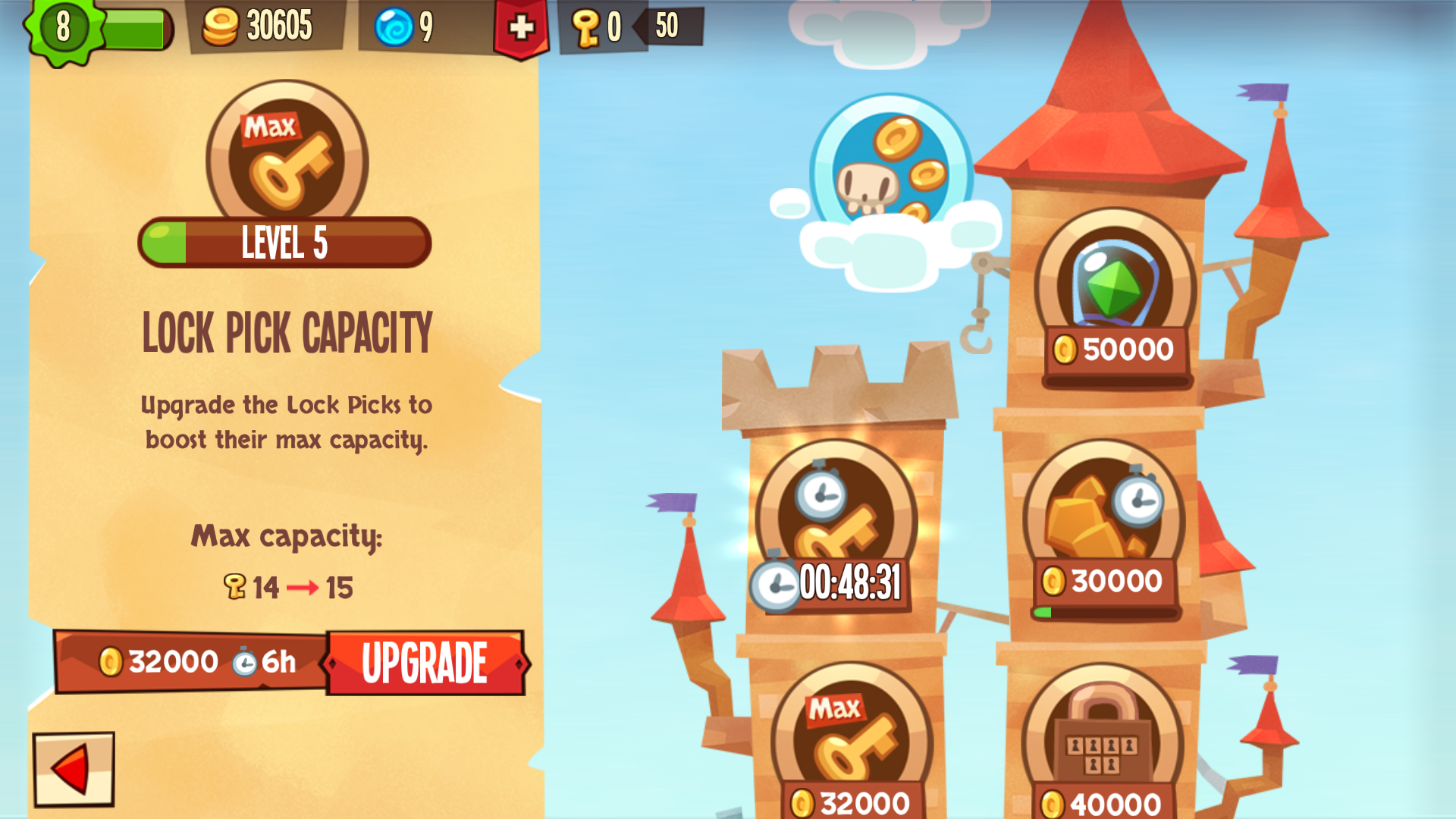
Step 4: Fuse Gems
The key to the meta and progression of the game is fusing of gems. Players collect gems from mines on the world map and by looting other players in the world. The player then takes the gems collected and fuses them in their base.
Fusing usually takes many hours (3+ hours for a usual gem). During this time the gems in this fusing ritual are open for stealing by other players. This is the most anxiety-inducing timer in the game. A gem will be stolen unless they keep the game open or have amazing defences. I spent about two hours on a weekend keeping the game open while watching movies because I was too afraid to close the app and lose my gems.
So why would players opt-in to this nerve wrecking timer?
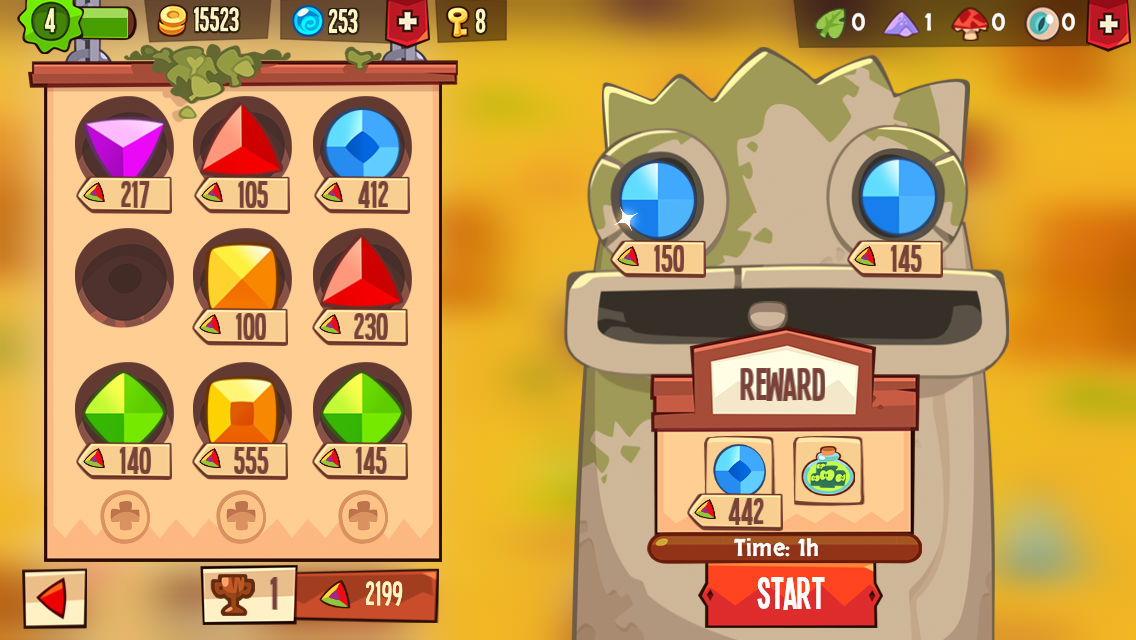
Increasing gem value is the goal of King of Thieves. The total value of your gems is how you rank in the game. Players are looking to retain only the highest quality gems (which is shown by a number). However, there are only limited slots the player can have to hold onto gems. So players quickly run out of slots and are forced to fuse gems together to make more slots for higher level gems.
This was a very, very smart design choice by ZeptoLab. This creates a natural cap for progression and creates a lot of very interesting choices for the player. It also creates an obvious high conversion item for monetization: the extra slots for gems. Similar to the builder in Clash of Clans, ZeptoLab has created a high conversion item out of these extra slots. I’m convinced that if they brought this to the forefront and made it cheaper for first time players, this could be a strong conversion item.
Step 5: Optimize Defences
After they’ve completed this loop: collect, attack, upgrade, fuse… what’s left?
Just like in Clash of Clans, players can extend their sessions by optimizing their dungeons defence layout and adjust the positions of traps. This comes with one caveat: the player must be able to beat their own level twice… in a row.
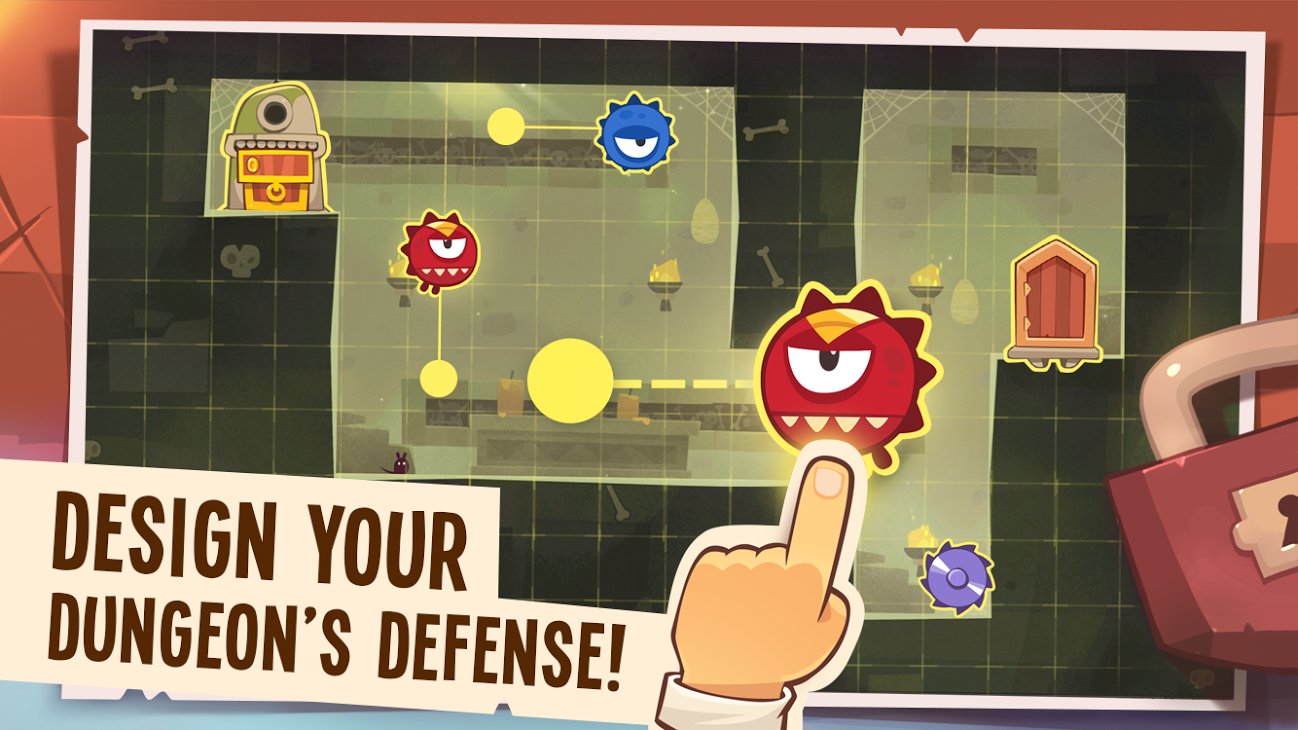
This definitely creates a session extension. I’ve spent well over a half an hour trying to create the optimal dungeon design. All this time was not incentivized by the game, but I wanted the best layout possible. This is exactly what you want to create in your session design. A session extender that players can take as little or as much time with as they wish. The value diminishes over time.
What King of Thieves did right: Social Pressure Mechanics
ZeptoLab shows an excellent example of how to add effective social mechanics to a game. Asking players for help to retrieve lost gems creates social pressure. I feel good about helping my friends, I enjoy when my friends help me out when I’m less active. I rely on my friends to help me optimize my fusing timers. The value of having active friends is apparent.

The league system creates a nice PvP environment with a clear reason to collect gems. Instead of feeling like I’m levelling up just based on some arbitrary number the designer has created for me (ex. collect 5000 gem value in 5 days), I’m competing against a living breathing opponent. I have to be engaged to compete, and the number is always growing so I never feel safe about my position. Sometimes I wish there were ways to specifically steal from other players on the leaderboard you were competing in. This would really drive up the competition.
King of Thieves also uses the same idea of clans in Clash of Clans. King of Thieves wants you to join a Guild. While the system is clearly in its infancy, it shows a commitment by ZeptoLab to the future of the game. Guilds are what will really drive the long term retention, and including it in the global launch was important. The mechanics at this point are still too early, but in the coming months I expect that ZeptoLab will build from this base and make very competitive play between Guilds stealing gems from each other. I hope they find a way that Guild members can work together on a dungeon or a raid. It would also be interesting to incentivize Guilds to put their most valuable gems in a vulnerable position. This will really drive competitive gameplay between the Guilds and give a collective goal.
What King of Thieves could improve: Hardcore Skill
In the translation of the Clash of Clans metagame to Super Meat Boy style mechanics, something fundamental was lost. Because platformer gameplay is inherently so skill-based, the translation still feels like a massive amount of skill is required to win.
Clash of Clans (as discussed before) although it requires some mix of stats and skill, the main determinate to win each fight is Stats. If you have an amazing army, you are going to win. If you have spent a ton of time (or money), you will be able to dominate against an opponent lower than you. As you defeat more of these easier players, you will be matched higher and higher in the leaderboards. This will demand more skill, but mostly more stats. This system allows players to “hover” around matchmade opponents that challenge their skill level, but still require high stats. Even if I’m terrible at selecting where my troops go, I’m still progressing, and I may be lower on the leaderboard compared to other players at my stat-level, but I still am progressing.
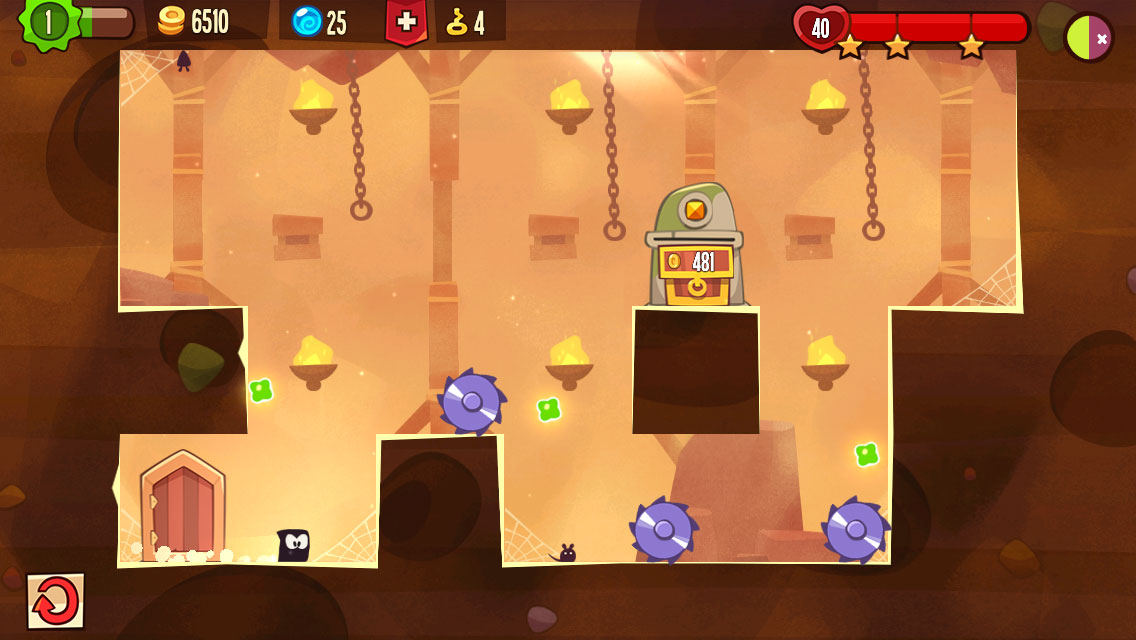
King of Thieves is never flexible over the amount of skill it requires from players. As you progress in the game, it keeps demanding more and more skill from its player base. As a result, the game feels very hardcore. The players that reach the end game are a smaller and smaller niche of highly skilled players. Why does this happen?
As the game progresses, players slowly get harder and harder obstacles they can place in their dungeon. In order to set up a dungeon that is difficult, the player has to beat it themselves. As a result of this system, unless a player is highly skilled, their dungeon, regardless of the defences, will remain at the same low level of skill-difficulty. There is no way for a player to increase their defence without actually being far better at the platforming game.
There are some stats that affect the game: the damage of the obstacles, your shadow’s equipment and armour, the amount of keys you have, etc. But these stats clearly take less of a precedence over the skill. In my opinion, there are some levels that you just need high skill. So as you progress in the game, no matter how much time or money you’ve put into the game, you will reach levels that it doesn’t have an impact if you don’t have the skill. There is no “hovering” in the matchmaking that allows players to feel progress regardless of skill. Players with low skill will feel it: they are punished by losing levels very often.
This is most likely an artifact of trying to combine a high-skill genre (Super Meat Boy) with Clash of Clans. While this pushes away players that are expecting a lower skill level, I think it also engages the highly skilled players even more. The tradeoff between a highly engaged niche target audience and a flexible broad audience appeal is incredibly difficult to get right.
The Results:
On launch, the app was featured by Apple. This drove hundreds of thousands of downloads, but has yet to crack the Top 100 US Grossing. Can it get there? This will be an extremely tough. After a featuring, the only way to drive the necessary volume to reach the Top Grossing Chart is to purchase installs. This is extremely costly.
However, the game supports very strong early day retention and with more work can improve their long term retention. With continual improvements, this game has a chance to reach a stable position in the Top 250 Grossing.
Personally, I’m cheering for ZeptoLab. This design is refreshing. I had the feeling that the mobile free to play space is even more risk-averse than the console/pc space. This feels like a step in the right direction. This is a game ZeptoLab should be proud to have worked on. I hope other game developers can look at this example on how to innovate in new genres
Mobile Game Design: Stats, Skill and Luck
All games feature three dimensions that determine player success: skill, stats and luck are required to win and progress in a game. However many prototypes and many games that I play each day seem to struggle with this mixture.
The main reason this happens is the player suffering from a lack of transparency about how they can improve. If your players can’t answer the question: “Why did you lose this round?” — then you have issues in transparency.
You need to seek ways to isolate and clarify the impact of Skill, Stats and Luck to make your game engaging.
The Importance of Stats, Skill and Luck
To start to fix these issues of transparency, it is important to define what the balance of stats, skill and luck your game is. Each is important for the success of your game.
Stats are essentially everything that the player invests in outside of the core gameplay. Most games have RPG stat systems that players are seeking to upgrade. For example, upgrading building defense stats, upgrading unit abilities, or upgrading the speed of a car. These systems are most likely what paces and slows down the progression of the player. A strong stat system is necessary if you want to ensure a level 100 player feels dramatically more powerful than a level 1 player. These systems are most likely what your players are investing real dollars to purchase quickly and to give them an advantage in gameplay. Without stats, long term gameplay is extremely difficult — there’s nothing players can invest in to get better at your game.
Luck is any systems in your game that are purely random. For example, the gems falling down during Candy Crush or Hearthstone deciding which card will be drawn next from the deck. These systems are important to create drama and entropy in gameplay. Luck ensures that the gameplay never is boring since a positive (or negative) action can happen at any time. Luck also widens the breadth of skill needed to master the game. Being able to craft the best deck is easy, but being able to handle the near infinite possible outcomes of card order is an extremely difficult skill to master.
Skill is any player choices or player interactions that have an impact on the outcome of your game. Skill is the player’s ability to time jumps in Mario, their ability to effectively place units in Boom Beach, or their ability to choose between cards to play in Hearthstone. This variable is by far the most important to a player’s retention to your game. Players that feel the game has no skill will not stick to a game. Fun and engagement come from learning and feeling smart about one’s decisions (Theory of Fun, Raph Koster). Without skill, there is nothing to learn, there is no game.
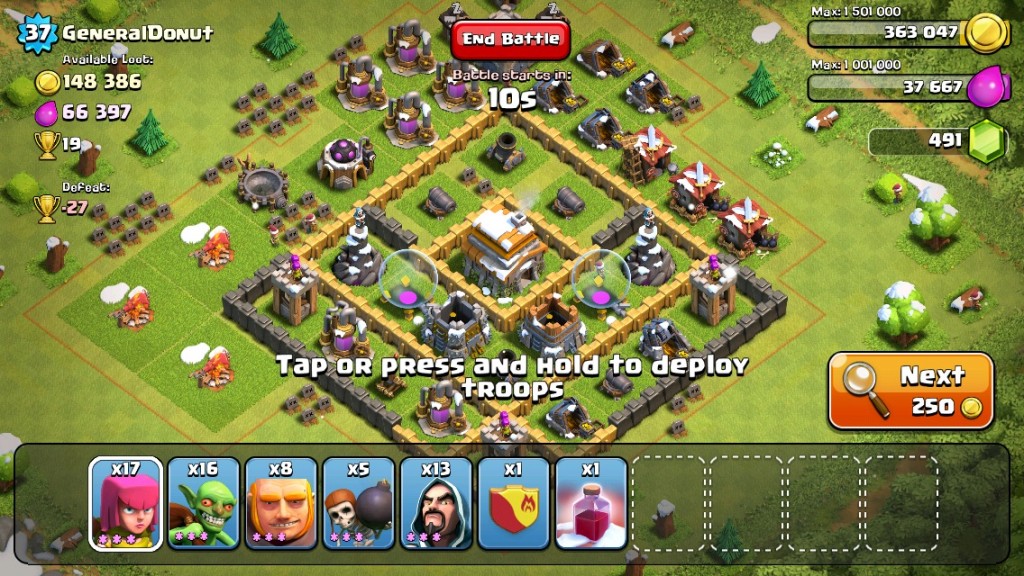
Clash of Clans focuses on Stats and Skill. Stats comes from Units & Buildings. Skill comes from the player being able to choose location of attack.
For example, Clash of Clans clearly focuses on Stats and Skill. There are very few sources of luck in the game. Players seek to upgrade their buildings with currency to progress in the game. Stats is clearly the strongest focus for Clash of Clans to ensure that progressing and upgrades are felt and long-lasting. Skill is secondary: players optimize placement of buildings and placement of units to defend and attack. Skill is controlled and balanced very closely by Supercell.
Candy Crush focuses on Luck and Skill. There are no upgrades in Candy Crush, just boosts. These boosts can’t be upgraded, and give a very clear (transparent!) benefit to the player. Clearly Luck is their largest focus, ensuring that each move a player chooses they never will be able to predict fully what will happen. This creates casino-like “near misses” that are only cured through replaying a level or paying for boosts.
Different games on the top grossing chart focus on different balances of Stats, Skill and Luck. A rule of thumb is to select two of stats, skill and luck as your game’s focus.
The more factors that are included in your game, the more likely you will have issues with transparency. When the balance of Luck, Skill and Stats is unclear to the player, engagement suffers.
Be as Transparent as Possible
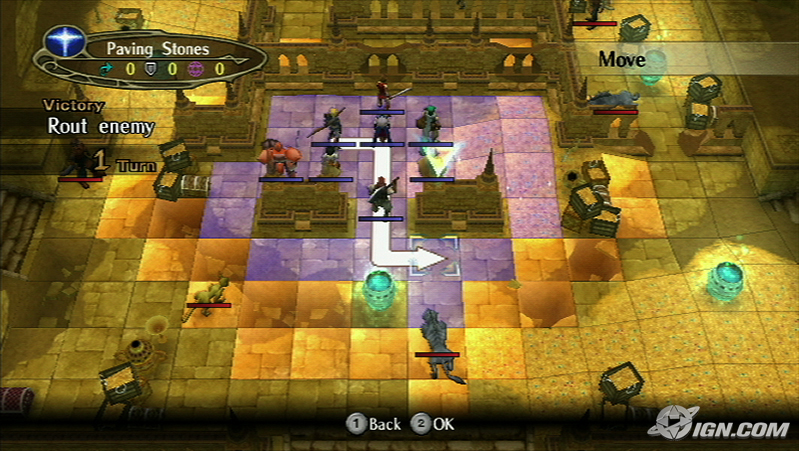
Fire Emblem Radiant Dawn. A Tactical RPG game. Control Movement of Units.
Let’s take for example a typical tactical RPG battle.
Each battle has a significant amount of variables that have an impact on its outcome:
- Each unit has stats for attack, defense, speed, attack range, etc. (Stats)
- A player can choose what unit types they want to bring into the battle. (Skill)
- Each turn the player chooses where their units will move and when they will attack (Skill)
- Each attack has a critical chance to do extra damage (Luck)
After a battle is concluded, the player lost. As a result, a player must ask themselves — what did I do wrong? How do I improve? What do I need to do in order to win this battle?
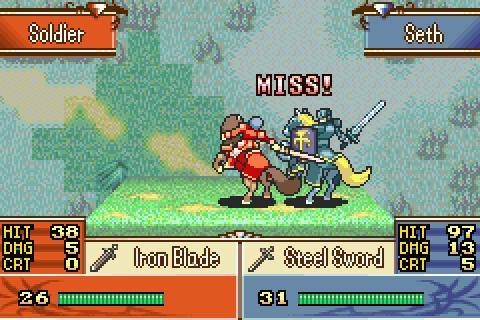
Fire Emblem. Stats, Skill and Luck go into the result of each battle.
It could be Stats: they need to upgrade their units more.
It could be Skill: they made poor decisions in the battle.
It could be Luck: they were just unlucky with critical hits.
Ensure your game is giving the player a clear answer.
When there are many variables determining your players’ success, it is best to isolate each variable as efficiently as possible.
When there are many variables determining your players’ success, it is best to isolate each variable as efficiently as possible. To isolate, you don’t always have to give feedback immediately when the action has occurred. Feedback on each variable can come before, during and after the gameplay.
Isolate Stats, Skill and Luck
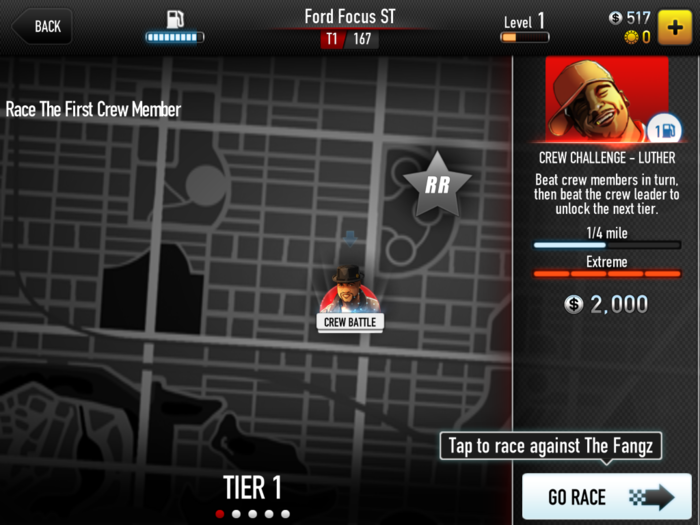
Immediately from looking at the bar, I know that this is an “Extreme” race. To win, I need to upgrade.
CSR Racing is an excellent example of how games can isolate each variable. Before a race, CSR Racing isolates Skill from Stats. Using a small progress bar, they compare the player’s stat level against the opponent. If the race is going to be extremely difficult, the player is warned before they begin. This helps the game in two ways:
- Drives desire for Stats. Stats are given a clear value in the game. Players clearly see that if they improve their stats, they improve their chances of winning.
- Avoids unnecessary losses on levels that are too difficult. Many times players will blame their skill above all other factors. If they continually play a level that clearly isn’t balanced for their level, they will eventually feel the game is unnaturally difficult and leave.
CSR isolates Stats before the race with this small UI change.
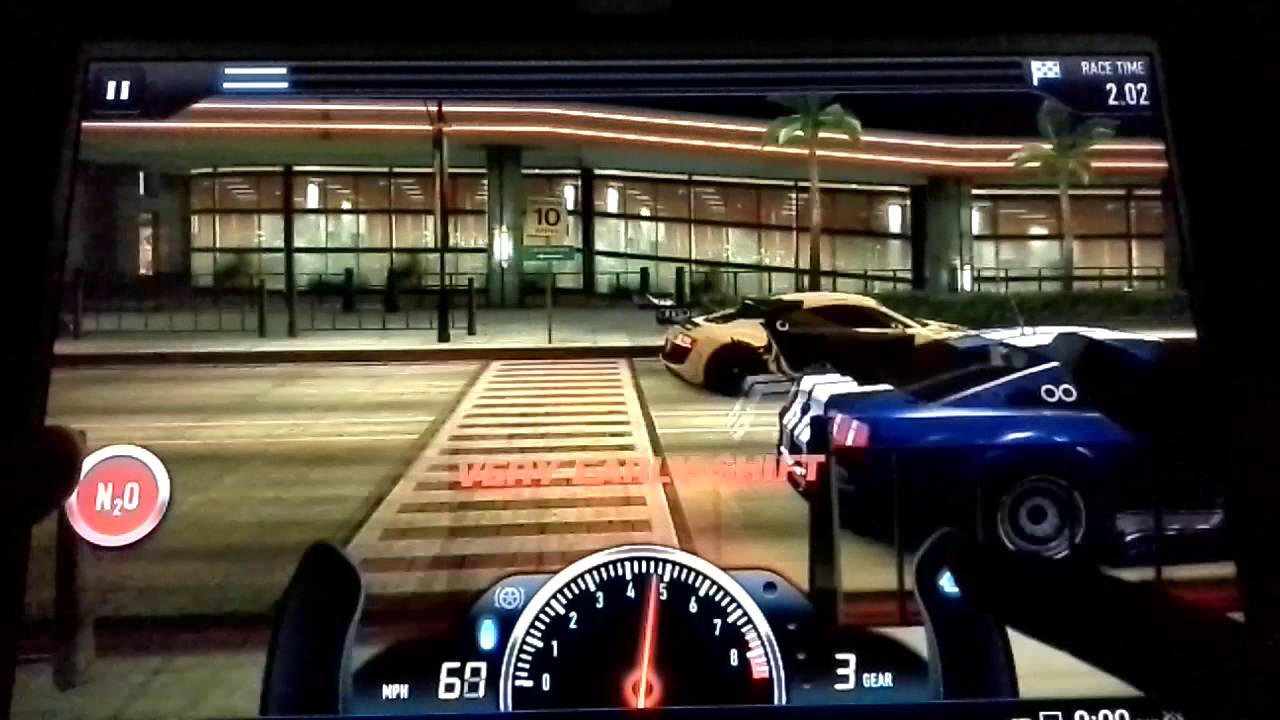
Throughout the race the player gets clear feedback about their Skill.
CSR also seeks to isolate how much skill impacts the outcome of a race. During the race, the player gets very clear feedback about their timing skill. “Bad Shift”, “Good Shift” and “Perfect Shift” come up throughout the race giving immediate, clear feedback about how well the player is doing. At the end of the race, the player clearly can say “I had all perfect shifts! I did everything I could!”. Vice versa, a player can say “I had some bad shifts in there, maybe next time I can improve my time…”.
Through these two small mechanisms, CSR has effectively isolated skill from stats. Players clearly know the reason for winning and losing, and can decide the best course of action to improve their chances.
A Tool for Transparency
To start to fix issues of transparency it is imperative that you play test your game often. When discussing the game with playtesters be sure to ask after each core gameplay round :
“Why did you lose this battle?”
“What could you have done differently to win this [battle/race/round]?”
“How did you figure this out?”
If they can’t answer these questions, it is time to improve your transparency.
To improve, list the inputs (Variables) and outputs (Feedback) of your game:
- Which variables impact the result? ex. Unit Stats, Unit Placement, etc.
- How do we give feedback about each of these variables?
- Which feedback systems are actually working? (players are acknowledging them in playtests)
- Can we give strengthen feedback for this variable before, during or after the round?
Strengthening feedback is dependant on whether the variable is stats, skill or luck driven.
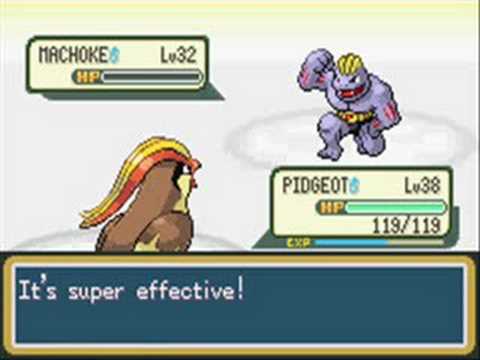
Pokemon is a good example of giving Skill-based feedback. Ensuring “Super-effective” comes up directly after the action make sure that players know that it was their skill that improved their outcome.
Variables that come from skill usually require more direct feedback immediately after the action is taken. For example, Pokemon gives the feedback “Super-Effective” immediately after a player has made a good choice about what attack to use against the opponent.
In Mario games, whenever mario is killed by a baddie, the game pauses and highlights exactly where mario was hit. This small and subtle trick ensures that players clearly see the reason for their failure and helps with learning.
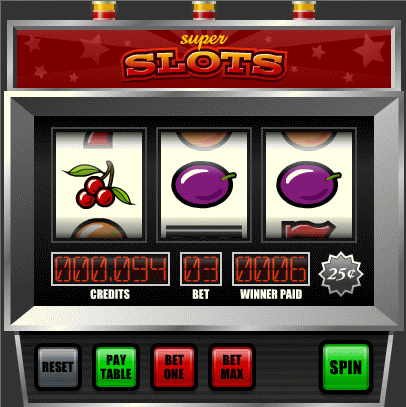
Slots, Dice, Cards are all clearly luck based. Use them to ensure players know what is random and what is not.
Variables that are luck-based can be made more transparent by using expected visuals of where luck comes from. Use a deck of cards, a spinner, or a slot machine. These are expected to be pure random. Players will quickly understand that they have no skillful impact on these results.
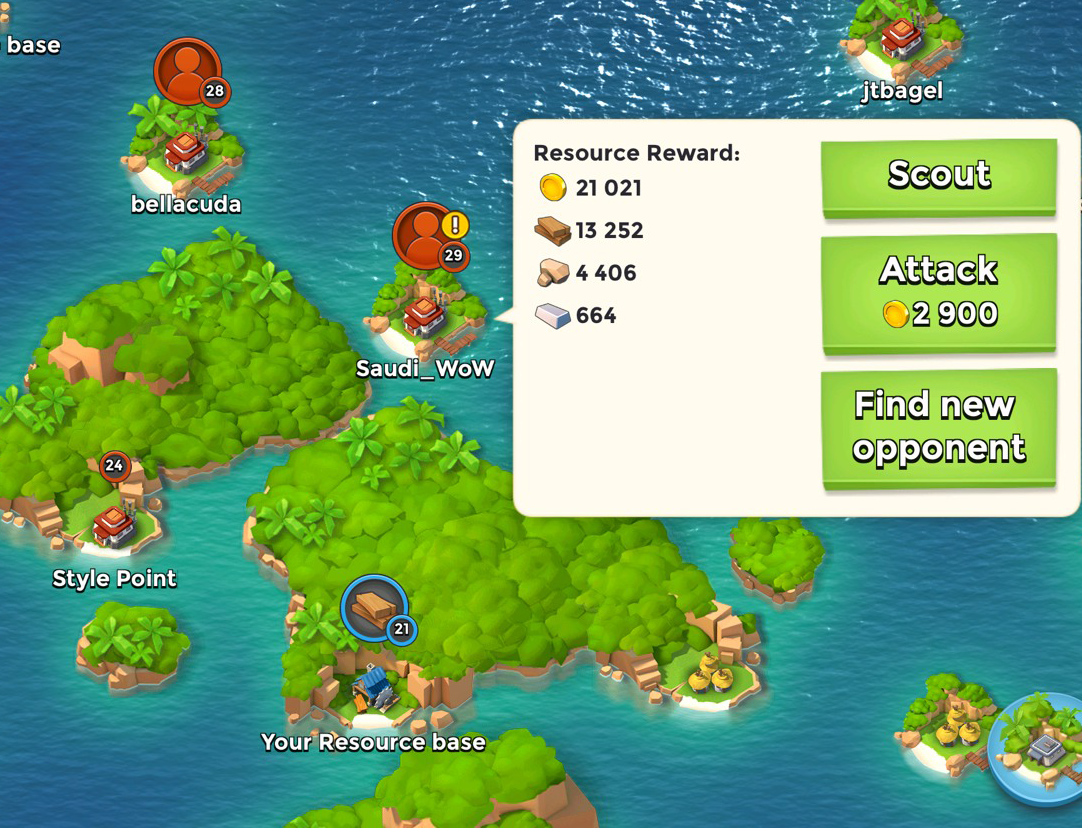
Boom beach warns players when their opponent’s level is too high, and gives players the ability to “scout” before committing. Ensuring players can make the right choice about who to attack based on their Stat level.
Variables that are stats-based are easiest to give feedback before the round begins. Ensure you warn players before they are going into a battle without the necessary upgrades.
As you add strength to these feedback systems, continually play test your game. When players have a clear idea of how to improve their chances, your game will be far more engaging.
Summary
To increase engagement in your game, seek ways to make your systems more transparent in terms of skill-based, stat-based and luck-based variables.
Stats, Skill and Luck each have their own benefits and drawbacks to a game’s success. Ensure you know the focus and balance for your game. Balancing for high levels of all 3 is exceptionally difficult, and can only be accomplished through isolating Stats, Skill and Luck in a transparent way.
To ensure high engagement to a broad audience, be as transparent as possible why a player won or lost in your game. Listing out the variables leading to the outcome and analyzing whether the player has enough feedback is the first step to reducing confusion.
Your goal as a designer: Players should always know how to improve.
Mobile Free to Play: Games that don’t want you to play them
More and more games now are adding modes where players no longer even need to play.
Players can simply open up the app, start a round, flip a switch, then put their phone down. The AI will make all their decisions. The AI will have all the fun while the player waits for the virtual reward at the end of the round.
At first glance, this is worrying. This turns the game into a Skinner box. Tap the button, wait, get a reward. Where is the fun in that?
Instead of making the core battle so boring that auto-mode is necessary, shouldn’t designers seek to add more depth to the battle?
No.
Focusing design on in-depth core game mechanics is a losing battle.
Focusing on making long-term decisions more interesting is a much better strategy for free to play games.
Battles are the Hook
In the RPG Genre, having an interesting battle mechanic provides the hook for the game. This is what draws players in and immerses them in the world. If I have no option of control, then this isn’t really a game.
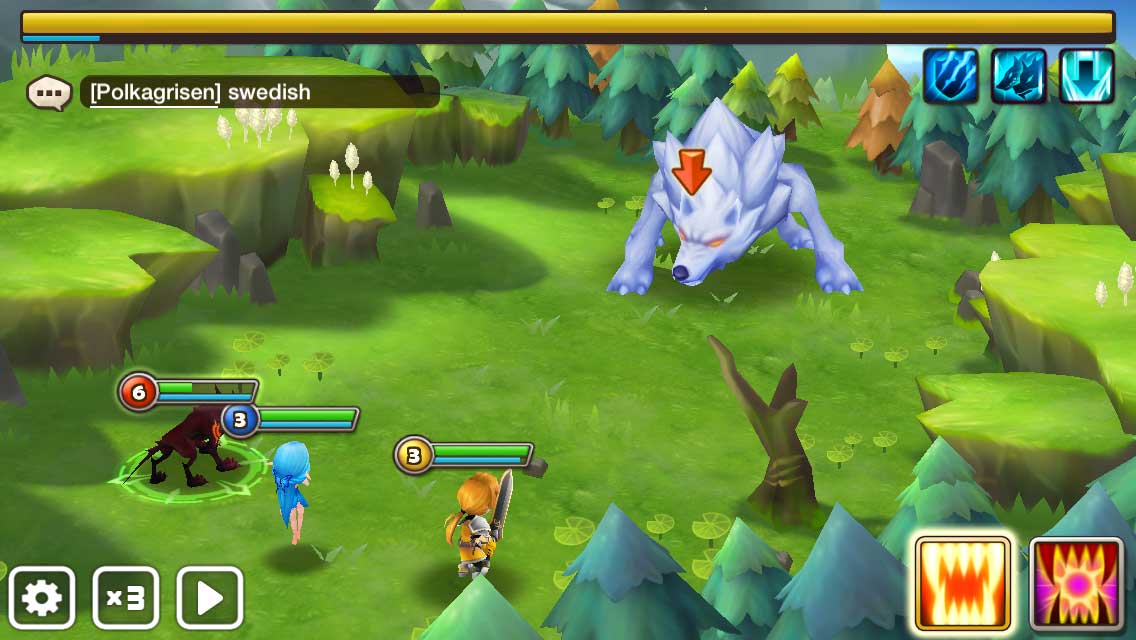
When a player starts a battle, they expect to make choices and see their impact. Having novel mechanics in the battle provides early players with a new experience that they have never had before. As seen above, in Summoner’s War, in the beginning, you have choices for each of your players of where they need to attack. This is engaging at first, but quickly goes stale. This isn’t the focus of the game.
Secondly, it really showcases the artwork. Your artwork sets the expectations right from the beginning. A player is only willing to invest in games that feel polished, exciting and professional. Making sure that players experience as much exciting battles in the beginning is important.
However, as they play many battles, inevitably the mechanic will get boring. Inevitably the artwork will get repetitive. There are few games in the history of game design that have ever managed to keep a core game mechanic interesting thousands of times repeatedly (ex. Tetris, Chess, Collectable Card Games). Especially in a non-multiplayer context, in a casual game, and even more in a mobile context where the interaction complexity possible is limited. In theory this could be done, but it would be incredibly difficult.
So how do you keep the gameplay interesting for the long haul while still allowing for a great initial experience?
Bitcoin Billionaire
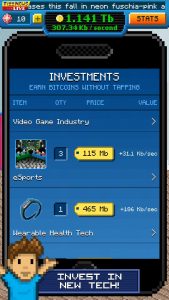
Bitcoin Billionaire is in a weird genre. I’m not really sure how to label it… It’s part simulation, but mostly an “Endless Progression” style game. Your goal is to try to collect as many Bitcoins as possible by tapping the screen.
Initially there is the appeal of just madly tapping on the screen. Each tap gets you 1 Bitcoin. You strum your fingers across your ipad watching your money go up. You’re so good at this!
But after about 30 seconds this starts to become a bore (also your fingers are getting tired!). So now the game starts to push you into making investments: earn Bitcoins while you’re not tapping.
What this does is ease the player away from a newly-boring core mechanic into something much more interesting: managing investments and optimizing the rate of progression. Bitcoin Billionaire has done an excellent bait and switch: you came for the tapping, but now you are addicted to buying income sources. Cookie Clicker, Make it Rain, Clicker Heroes and Bitcoin Billionaire are four excellent examples of games that have managed to ease a player from a boring core mechanic into something that is much more interesting in the long haul.
This transition is exactly what all games need to deliver for successful long term retention. So how do we add this to other genres?
Auto-battle is how its been added to the RPG genre. Eventually the game recognizes that making choices in the battle is no longer interesting. The bait and switch becomes making the choices outside the battle more interesting than the battle itself.
But Auto-Battle isn’t a trivial system to add. Like all design decisions it comes with benefits and consequences.
There are 2 questions to ask if an Auto-battle system will work with your game:
Session Design: Auto-Battle or Job system?
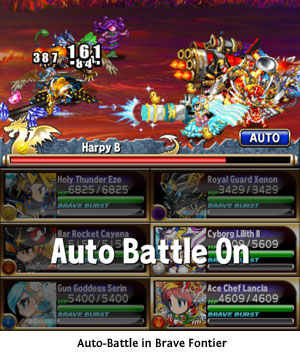
Auto-Battle as a system essentially means that a player will make a choice about which “dungeon” to enter, then leave their phone on and come back to it after a few minutes.
Is this valuable to your session design? Players just opening your app for long periods of time? It will effect your KPIs — your session length will go up. But is that really what you want in the design? Successful games push players to return to the game often throughout the day and focus on meaningful choices. So why demand that they keep the app open during the battle?
Job Systems in games have been around for quite awhile. They reached a peak with games like MafiaWars in the early days of Facebook. A player would send their units on Jobs. Tap a button, and the unit would be disabled for a limited time. When the time was up, the rewards for the action were given. This was a nice appointment mechanic that allowed players to opt-in to coming back to the game. If the game was only job systems however, the game grew stale. But what if a Job System replaced the need for auto-battle?
What may be more interesting is asking the player to make a choice: Do I send my fighters out without my control for 5 minutes, then return with the loot? Or do I think the AI will mess up this battle, so I should do it manually for the next 10 minutes? This way players can make a choice whether to end their session and come back later, or improve their chances of winning by playing the actual battles manually.
Is there enough depth outside of the battle?
If the game is really distilled down to a few taps each day this can get boring quickly.
Grinding for rewards and items is only fun when there is significant complexity and depth to collecting items.
By adding auto-battle in the game, this will put much more stress on your long-term meta mechanics. Do your players have enough interesting decisions outside the battle that will last for months?
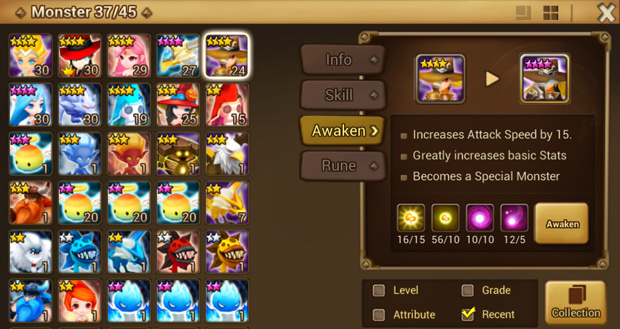
Summoner’s War has Relics to provide interesting decisions in how you upgrade your players. Brave Frontier has the boosting and fusing mechanic which provides years of collection and interesting long-term trade-offs. Many games have a very in-depth loot system which makes for interesting decisions choosing which gear to keep.
However, even with a strong loot system with collection, players need an indicator of progress. They need to be immersed in your setting, story and game. Having an auto-mode is great, as long as eventually players will be pushed to an epic boss battle. A battle that surprises them, challenges them, and maybe even progresses the story. This will be necessary wrapper around the grinding that makes it all worth it. These auto-battles end up building anticipation to something new and exciting for the player.
In the end auto-battle lets players focus on the choices and decisions that matter to them, no matter what stage of the game they are in.





















































